K-Pop Stars and Metal Cutlery: A Short and Sweet Ride on a Korean Air 777 from Seoul Gimpo to Beijing
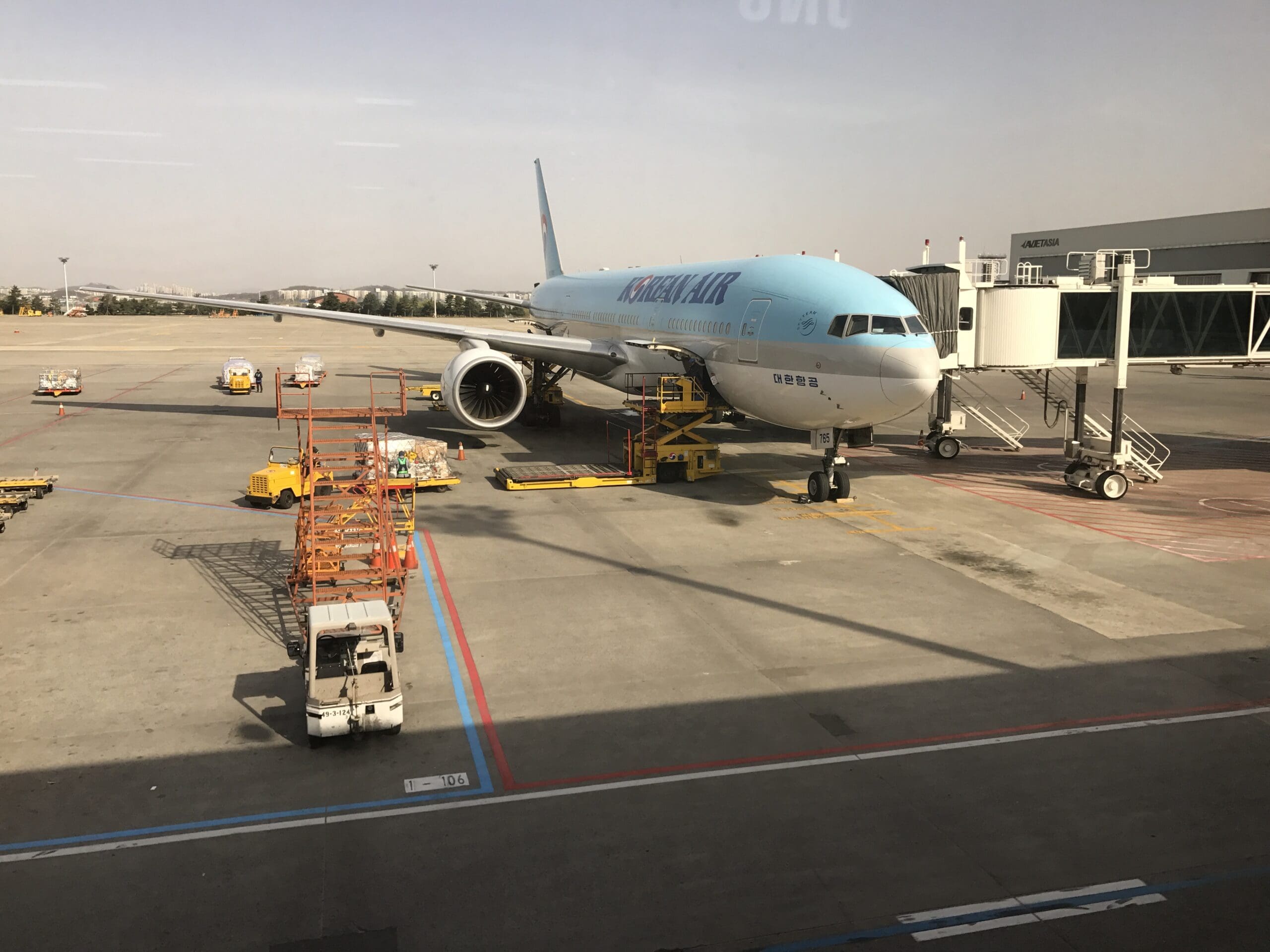
Disclaimer
This trip took place back in 2017, I have reuploaded this as I have recently moved blogs! Korean Air continue to fly between Seoul Gimpo and Beijing Capital Airport. However, this route is now most commonly flown with a Boeing 737 MAX 8.
You can skip to the flight by clicking here.
Background
With snowy mountains, subzero temperatures and icy pavements, Korea in January seems a world away from Dubai’s golden deserts and sandy beaches. One January evening, after trudging through the neon-lit streets I arrived back at my nicely heated apartment and upon removing my coat, gloves and scarf, I noticed that I had received a message from my parents. It had been decided that there would be a family reunion in Dubai that April which would coincide with my university’s Easter holidays. With my parents living in the UK, my sister in Dubai and myself in Seoul, the city seemed to be a geographically logical choice. I thus wasted no time in searching for suitable flights!
Due to the short length of my university’s Easter break, I would only be able to depart Korea on Wednesday and have to arrive back in the country early on Monday morning at the latest. With this considered, my options were limited to only relatively direct flights. For those with little interest in aviation and an unlimited budget, the most obvious choice would have been to fly direct from Incheon onboard either an Emirates Airbus A380 or a Korean Air Airbus A330. However, tickets for both services were priced significantly above my budget. Aside from these two carriers, both Air China and Cathay Pacific offered decent flight times on services via Beijing and Hong Kong respectively. Although prices for these were still a little high, and from an enthusiast’s standpoint, little diversity was provided with Airbus A330s scheduled to operate all flights on both airlines. I then turned to look at the big two Chinese SkyTeam giants – China Eastern Airlines and China Southern Airlines. The former offered good prices and reasonable journey times, although, on the return leg, I would have to transfer between Shanghai Pudong and Hongqiao. Having flown with China Southern Airlines a total of three times in the year before my trip to Dubai, I knew what to expect from the airline – a mediocre level of service, varying degrees of comfort and little by way of inflight entertainment. What they did offer however were some interesting routings on a smorgasbord of aircraft and departures from the convenient Seoul Gimpo Airport.
After much deliberation, I settled for a geographically direct route for the outbound leg which would essentially follow the same path as a direct flight between Seoul and Dubai. This involved departing Seoul Gimpo on a comfortable Korean Air Boeing 777-200ER, arriving in Beijing a couple of hours later where I would connect onto a China Southern Airlines Airbus A321 which would take me westwards to Urumqi. The final flight of the outbound trip would see me fly onboard one of East Asia’s very few remaining Boeing 757s down to Dubai. Meanwhile, my return journey would take me from Dubai to Guangzhou and then onwards to Beijing Capital, with these legs operated by the Airbus A330-200 and Airbus A380 respectively. Ending my journey how it started, I would hop back to Korea on a late night Korean Air Boeing 777-200ER, although I would arrive at Seoul Incheon as opposed to Seoul Gimpo.
Booking
Having previously used China Southern Airlines’ website to book flights, I was confident that this would not present too many hurdles. Fortunately, I was correct and found little issue with booking – although unfortunately, my repeated attempts to enter my Korean Air Skypass number and to select seats ended up in an error message. Once this was done, I received an email confirmation and put the trip to the back of my mind for a couple of months.
As departure day approached I began to look forward to my trip. However, all was not completely plain sailing and five days before departure, my phone buzzed as I received a call from a mysterious international number. Uncertain as to who this was, I answered the call and was soon informed in broken Korean that my flight from Beijing to Urumqi had been rescheduled. Whilst I was not made aware of the new departure or arrival times, given the fact that China Southern Airlines operates plenty of services between Beijing and Urumqi every day, I was not particularly concerned. Unfortunately, when my new itinerary reached my email inbox several hours later, I realised that there was a major issue. Specifically, this email read:
‘We apologize for the inconveniences this change might cause. Your current reservation information is as follows:CZ4504 2017-04-12 GMP(JINPUGUOJIJICHANG)–PEK(BEIJING) 0920 1030CZ6931 2017-04-13 PEK(BEIJING)–URC(WULUMUQI) 0740 1150CZ6069 2017-04-12 URC(WULUMUQI)–DXB(DUBAI)’
The eagle-eyed amongst you will realise that China Southern Airlines rescheduled my flight from Beijing to Urumqi to the day after my flight from Urumqi to Dubai! I thus immediately picked up the phone and after a short wait I found myself speaking to someone who didn’t quite understand my issue. Eventually, I was able to convey the message that I wanted to rebook onto a flight that would allow me to make my connection in Urumqi and I was offered a seat on the 1250 Beijing to Urumqi flight departing five minutes before the flight I was originally booked on. I have absolutely no idea why I wasn’t rebooked onto this flight in the first place, but I was thankful that there were still seats available on this service. Once I had confirmed my name, passport number and other contact details, the call ended and I became a little bit worried about the fact that I received nothing my means of a confirmation of this. Meanwhile upon entering my details into both the China Southern website and app this informed me that my second flight was still set to depart after my third. After two days, I called China Southern’s call centre once again where it was revealed that an error had been made and the new itinerary had been sent to the wrong email address. Once this change had been made, I received my new itinerary within a couple of hours and could finally look forward to my trip!
The Flight
Admittedly, the entire pre-departure fiasco did little to make me look forward to my China Southern Airlines adventure. However, I was still thankful to be getting away for a long weekend in the Emirati sunshine and I was rather happy when my departure day arrived without further drama!
As airports go, I am very familiar with Seoul Gimpo International Airport, having flown through this plenty of times, primarily on my way to and from the island of Jeju. However, considering the airport’s limited number of international flights, this would be my first time passing through the airport’s international terminal and, falling into the strange demographic of airport enthusiast, I was rather looking forward to this new experience. With my flight scheduled to depart Seoul Gimpo at 0920, I could have probably left home at some point after 0700 and still comfortably made the morning flight to Beijing. However, not wanting to cut things too fine, I woke up bright and early, and after a quick shower, I made my way out of my warm flat and into the cold and dark early morning backstreets of Seoul.
Living on the western fringes of the Korean capital, getting to the airport would be an easy task, involving a couple of quick train rides. Upon leaving my one-room, I headed uphill for about eight minutes before arriving on the chilly platform of Sinchon Railway Station. Having studied the schedules in advance, I arrived there with just three minutes to go until the next westbound Gyeongui Line service, and right on time, this came hurtling into the platform. Whilst this line theoretically connects the South Korean capital, Seoul, with the North Korean capital, Pyongyang, that day, my train would just be running as far as Munsan, a small town to the south of the Demilitarized Zone. Soon, I disembarked at the sprawling station of Digital Media City, the first neighbourhood that I ever lived in in Korea, where I transferred onto an Airport Railroad Express service for a quick spring across the Han River. In total, the entire journey to Gimpo Airport took a rather standard thirty minutes, at least half the time it would have taken me to reach Seoul Incheon Airport.
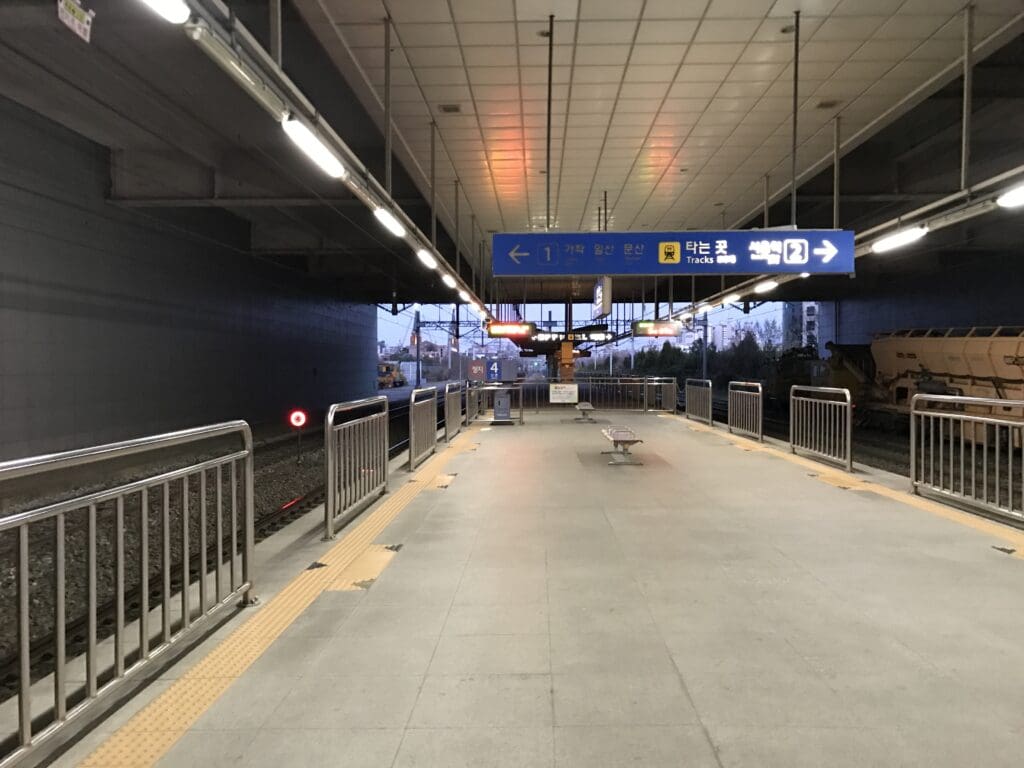
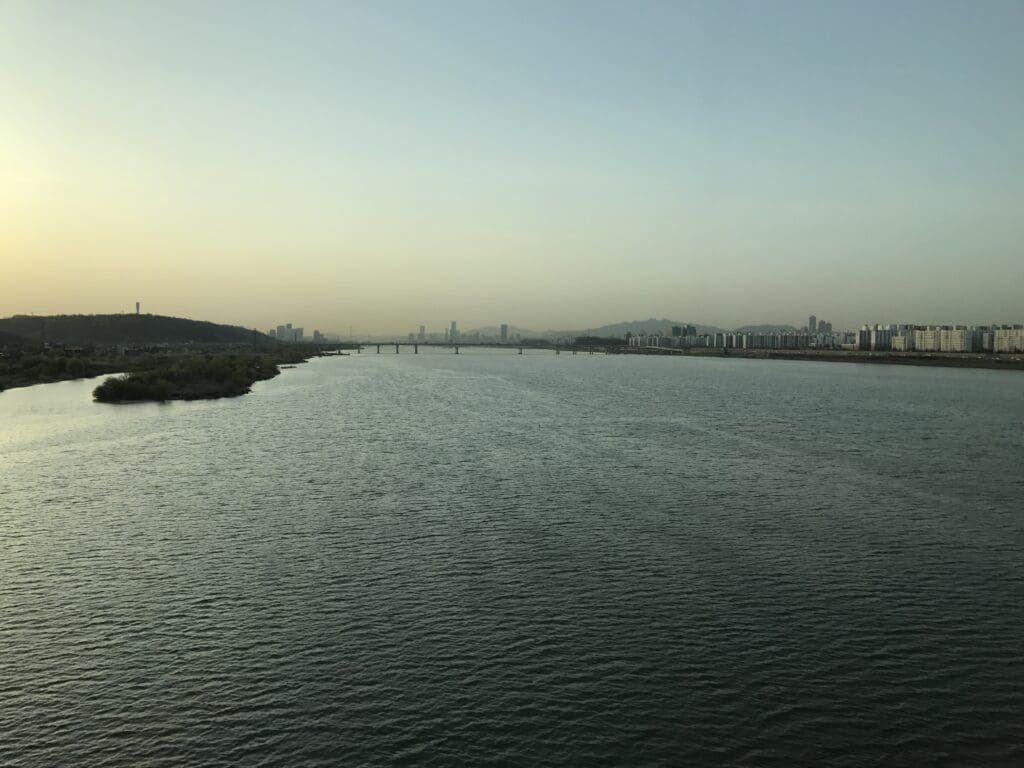
Whilst Seoul Gimpo Airport enjoys great transit connections to destinations across Seoul, Incheon and the surrounding Gyeonggi region, the airport’s train station is a fair walk away from the airport’s two detached terminals. From the westbound Airport Railroad Express platform, located deep underground on the station’s lowest level, I headed up three long escalators before arriving at the gate line. Once there, I tapped out, and for the first time, I turned right and made my way towards the international terminal, rather than left towards the domestic terminal. Fortunately, long, well-polished and travelator-equipped underground passageways connect the station to the two terminals, enabling passengers to reach these without having to brave the bitterly cold of winter or the humid summer heat.
Several minutes after tapping out, I reached the terminal and following a couple of escalator rides, I found myself standing in the large, spacious and cavernous check-in hall. Looking around, whilst this may have been the height of luxury in the 1980s, compared to Korea’s main international hub at Seoul Incheon Airport, this was rather dated in its appearance. Nevertheless, this was spotlessly clean throughout, complete with fast complimentary wifi and plenty of charging points, and home to an acceptable number of shops and eateries for those looking to pass the time before heading airside.
Unfortunately, the landside portion of the terminal lacks airside views. Thus, wanting to check-in as soon as possible so that I could head airside, I decided to make a beeline for Korean Air’s large and well-branded check-in area. This was home to an army of staff waiting and eager to guide passengers towards the many self check-in machines. Seeing as I was almost entirely certain that my itinerary would completely stump these machines, I attempted to head to a desk, only to be pulled aside and escorted to a machine. One thing that noticed that morning is that these machines cannot really be described as ‘self’ check-in machines, and a polite and friendly staff member insisted on operating this for me. Perhaps expecting that I would simply be heading to Beijing, Shanghai or Tokyo, the staff member reacted to my ticket to Dubai with some surprise – not least because my middle flight was still shown as departing the following day! Once this staff member had entered my journey details onto this machine, as I had expected, an error message flashed up and I was advised to head to a counter. Fortunately, thanks to the staff members’ mission to siphon off passengers before they reached these desks, whilst most were manned, these featured no queues and so I walked straight up and explained my situation.
Following a slightly worrying wait, I was asked to prove that I held a visa for the United Arab Emirates. However, British citizens, as with those from South Korea, are not required to hold a visa to visit the country and it took some persuading to convince the check-in agent that this was indeed the case. Funnily enough, over seven years later I would find myself in the exact same situation at Seoul Gimpo Airport when flying to Dubai via Beijing with Air China! Following another wait, two Korean Air branded boarding passes were printed off for my first and second flights. Unfortunately, for whatever reason, the staff could not check me in for my ride from Urumqi to Dubai, however, seeing as I had three hours in Urumqi, I hoped that this would not be an issue.
With my boarding pass in hand, I made my way up the escalators and soon arrived at the end of the short queue to enter the terminal’s single security checkpoint. After shuffling along for a minute or so, I had my boarding pass scanned before I entered the comparatively small security hall. Fortunately, despite its size, all checkpoints were open and I was thus able to breeze through with minimal effort. Next up was immigration, and, with this being a quick and easy check, I was left with no complaints whatsoever about the time it took to reach the airside portion of the terminal building.
Seeing as it was the first time that I found myself in Seoul Gimpo International Airport’s international terminal, once airside, I decided to have an exploratory wander around. Overall, my first impressions were for the most part positive, importantly, I found the terminal to be spotlessly clean, with plenty of seats, toilets and charging points offered throughout. However, in terms of its design, this was decidedly less modern than its counterpart to the west, Seoul Incheon Airport, and, the airside area lacked the same cavernous grandeur as the check-in hall. Considering that this terminal once served as Korea’s main international gateway, I was a little surprised at how compact this terminal is, covering a small area and home to just a small handful of facilities. In this portion of the terminal, nothing more than a couple of cafés, a duty free store and a book shop could be found, however, seeing as Seoul Gimpo’s international terminal is the Korean capital’s answer to London City Airport, most passengers probably do not spend too much time lingering around in this portion of the terminal.
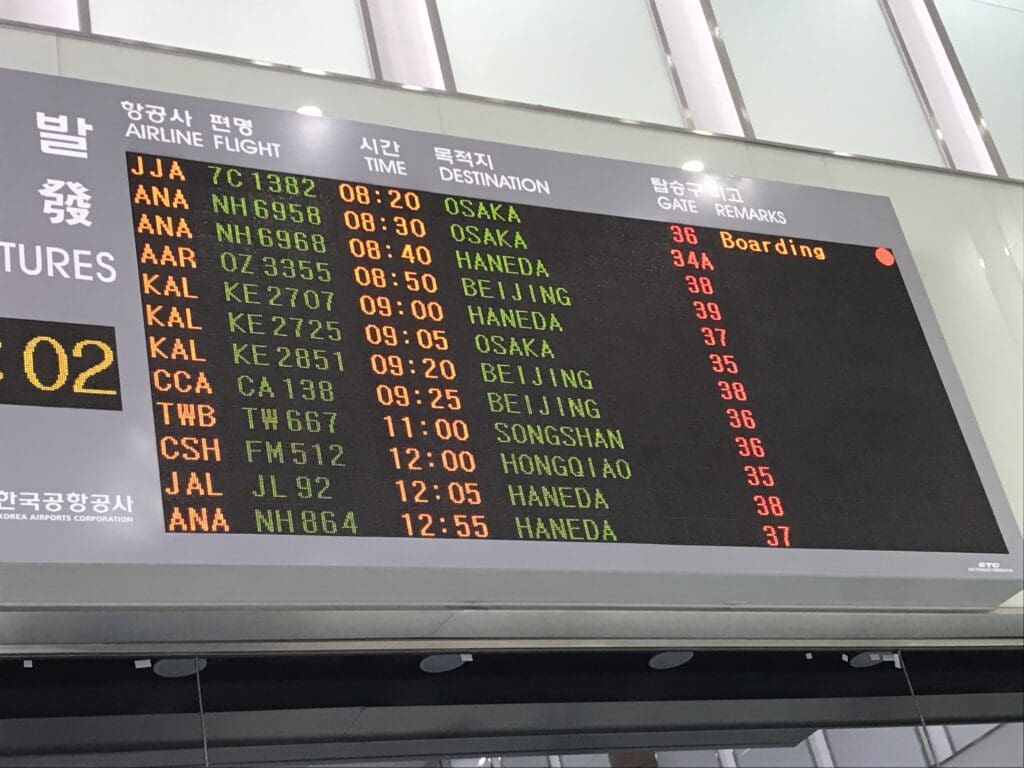
Importantly for aviation enthusiasts, large windows allow for views of the ramp outside from many of the terminal’s gates. However, thanks to the layout of the airport, these do not face the runways, and thus little could be seen other than the airport’s westerly ramp. Inside the terminal, as time passed this became a little busier, with a smorgasbord of flights departing to all destinations served from the terminal. Namely, flights could be seen departing to Beijing Capital, Osaka Kansai, Shanghai Hongqiao, Taipei Songshan and Tokyo Haneda, with these services operated by Air China, ANA, Asiana Airlines, Eastar Jet, Japan Airlines, Jeju Air and Korean Air. In terms of aircraft types, these services were operated by Airbus A330-300s, Boeing 737-800s, Boeing 767-300ERs and Boeing 777-200ERs.
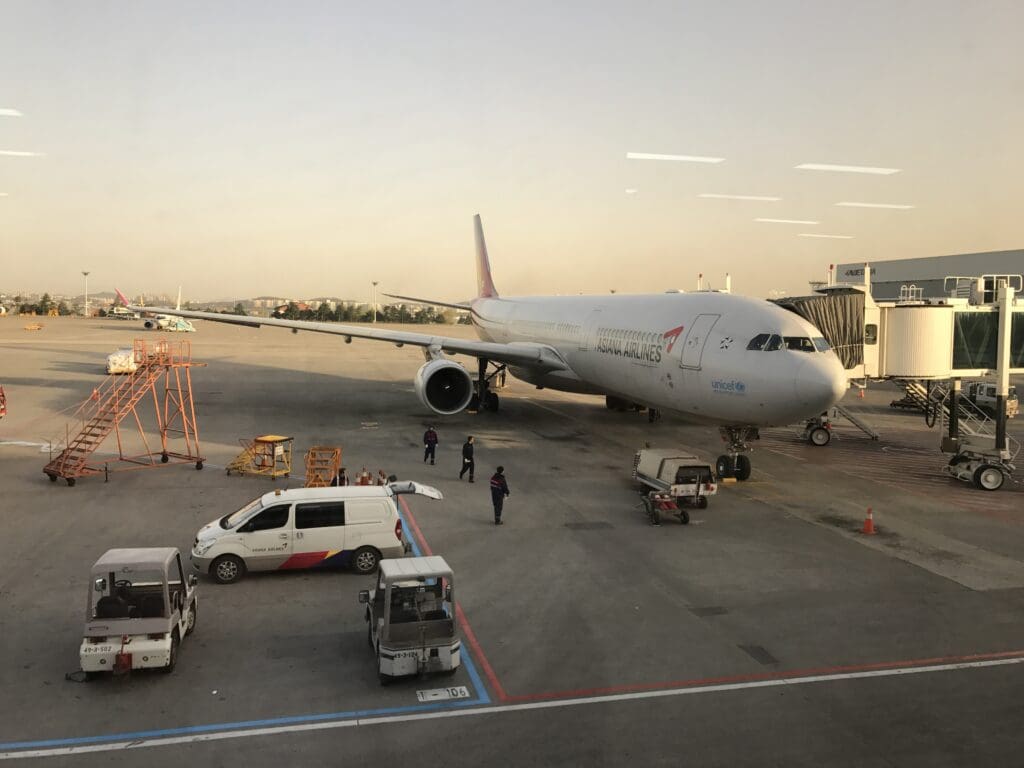

Inside the terminal, whilst Seoul Gimpo’s international operations are more aimed at those flying for business, that morning most appeared to be Korean leisure flyers, including couples and families jetting off on holiday. Providing some excitement during my stay, at 0840 I heard a sudden stampede of paparazzi and the continuous snap of cameras as a K-Pop boy band marched past me on their way to Tokyo. Not being all too au fait the genre, after some research I discovered that this troupe was the relatively famous international fourteen-piece NCT!
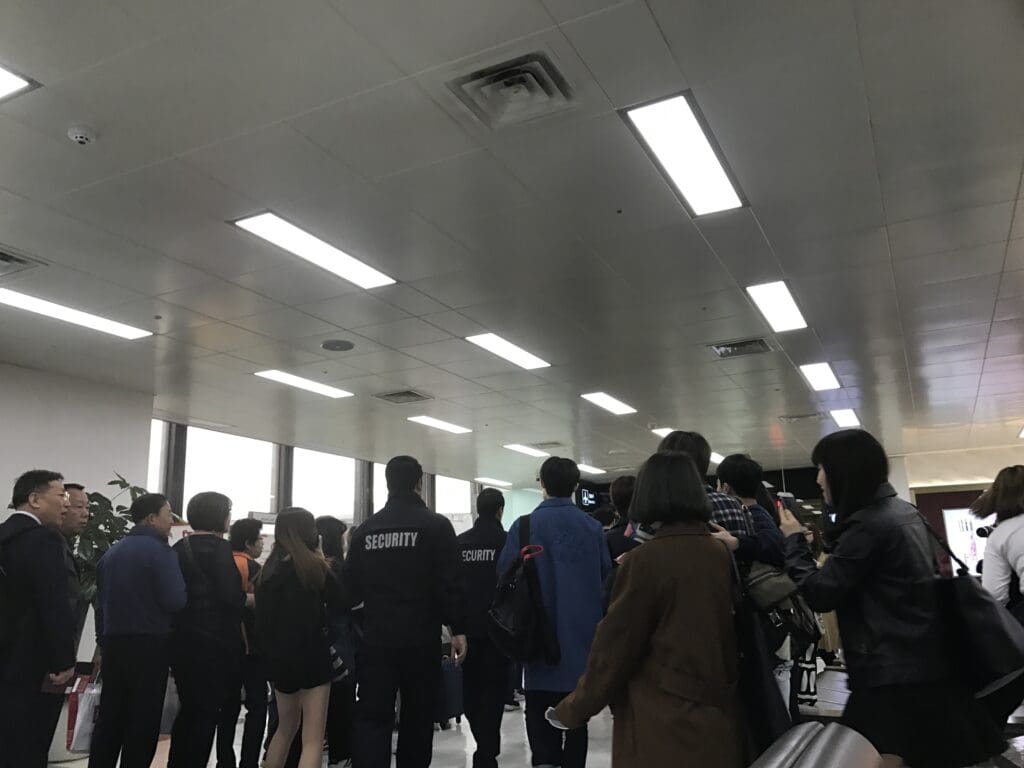
As I have found to be the case with all Korean Air departures from Seoul Gimpo International Airport, regardless of aircraft size, boarding for my flight to Beijing Capital was scheduled to commence just twenty minutes before our scheduled departure time. Looking outside, at 0850 I watched as our Boeing 777-200ER was cautiously towed into Stand 38, and once there, the process of loading meals and cargo soon began. Seeing as this jet had operated six return sectors between Seoul and Jeju the previous day, this had spent the night over at the domestic terminal. That morning, the task of flying to Beijing had fallen to Boeing 777-2B5ER, HL7765. Manufactured in 2008, this aircraft first took to the skies in April that year, with the nine year anniversary of its maiden flight coming just four days after my flight. Following testing, in May 2008, the aircraft was handed over to Korean Air and ferried across the Pacific to its new home. In the week prior to my flight, this aircraft had flown 26 sectors, covering around 14,200 miles between Gimpo and Beijing, Jeju, Osaka Kansai and Tokyo Haneda. According to the AvHerald at the time of my flight this particular aircraft had not experienced any notable incidents or accidents during its lifetime.
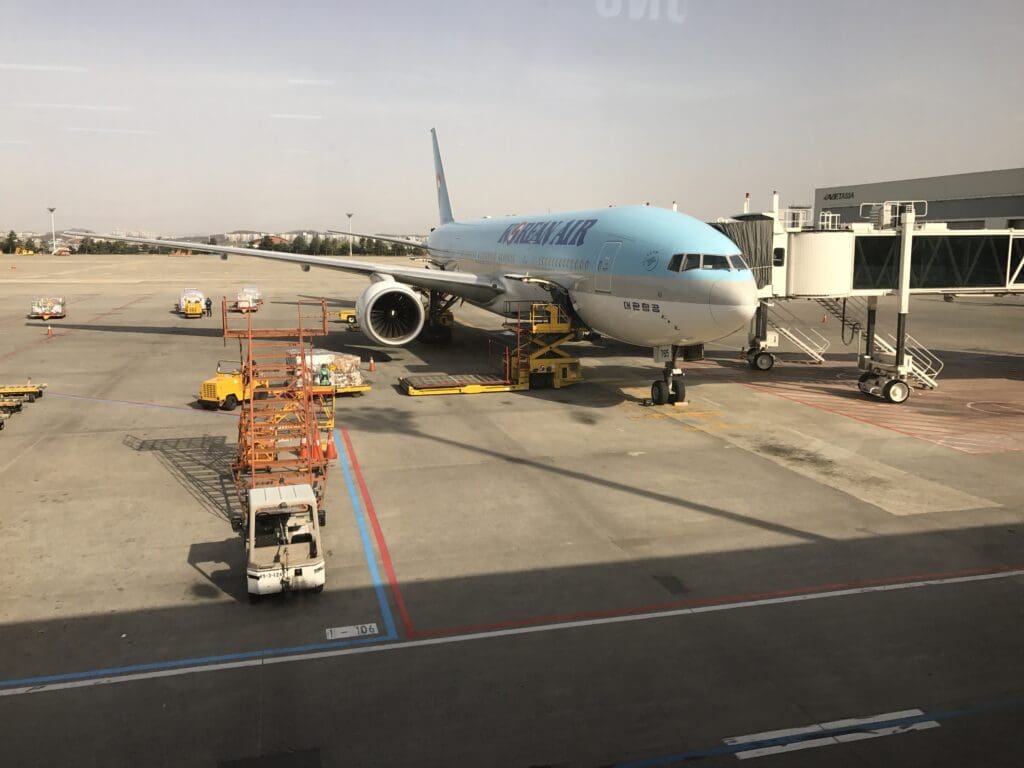
Moments after the aircraft arrived on stand, things began to turn a little pear shaped when I was approached by a flustered looking Korean Air staff member who asked me to hand over my boarding pass for the Beijing Capital to Urumqi sector of my trip. Communicating in Korean, I was given no explanation for this, and I was simply advised that I would have to check-in again at Beijing. Feeling a little confused, at 0855, a gate agent performed an announcement in Korean and English requesting those requiring assistance, elite members of Korean Air’s frequent flyer programme, Skypass, and passengers travelling in Prestige Class to board the aircraft. At that time, a small cluster of passengers formed around the gate podium, and, giving some hope that it would be a quiet ride, relatively few passengers could be seen lingering around the gate area. Once these passengers had began to board the aircraft, a small queue of eager passengers formed at the gate podium, however at 0900 an announcement was made informing all those bound for Beijing that the flight had been delayed by an hour and a half.
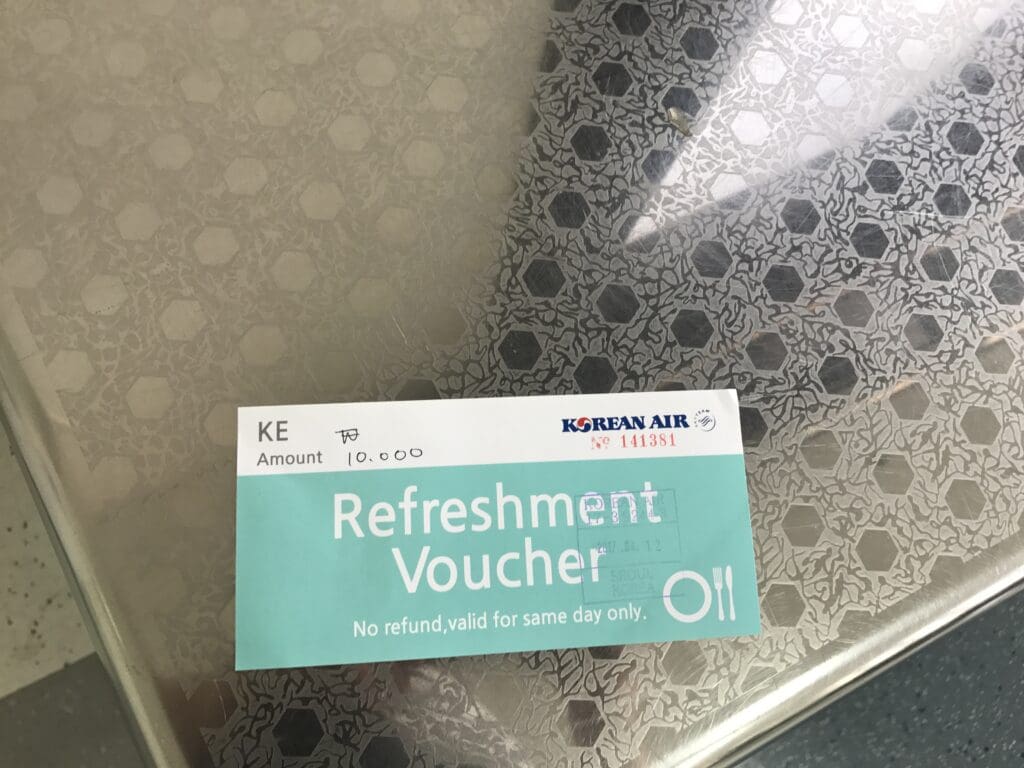
With my connection at Beijing Capital Airport’s Terminal 2 now reduced to 55 minutes, requiring a trip through immigration and now having to re check-in for my flight to Urumqi, I was fairly certain that the chances of making my onward connection were slim. On the plus side, almost as soon as the delay had been announced, an army of Korean Air staff made their way through the gate area distributing food coupons worth 10,000 won each which could be spent in either of the terminal’s two cafés, both of which ended up rather crowded. Seeing as the situation was entirely out of my control, there was nothing I could do and thus I tried not to worry too much as I sipped on the coffee that I had purchased with my voucher.
Following over an hour in limbo, at 1020 the gate staff performed an announcement in Korean and English advising all passengers of boarding’s commencement. Unlike the first time around, this was not announced in any particular order and all passengers were invited to board simultaneously. Joining the short and orderly queue leading up to the gate podium, once at the front, my passport was checked and my boarding pass was scanned before I was free to continue the short way down to the glistening Boeing 777 adorned in the familiar and iconic blue, white and silver livery of Korea’s national carrier. Being a widebody jet, two jetbridges were connected to the Boeing’s L1 and L2 doors, although the former jetbridge was reserved for the exclusive use of those in Prestige Class.

Following a short wait, I stepped into the galley that separates the Boeing’s two Prestige Class cabins where I was welcomed with a warm and friendly greeting from one of the two flight attendants standing there. Once they had checked my boarding pass, I was pointed down the first aisle and made my way into the two-row rear Prestige Class cabin. Whilst I would have not rejected the opportunity to spend the short flight to Beijing in one of the premium cabins, the seats there came in the form of somewhat dated B/E Aerospace Minipod lie-flat seats, each of which was covered in a turquoise fabric giving off a rather clinical aesthetic. Despite being far more luxurious than the recliner seats of most full-service East Asian narrowbody jets, and more than adequate considering the short length of the flight, these definitely lag behind the business class seats of many major airlines’ widebodies. Furthermore, at the time of my flight, Korean Air scheduled their Boeing 777-200ER jets on long haul services to the likes of Istanbul, Madrid, Tel Aviv and Zurich, and I can imagine that some passengers may end up disappointed with this product on such long flights.
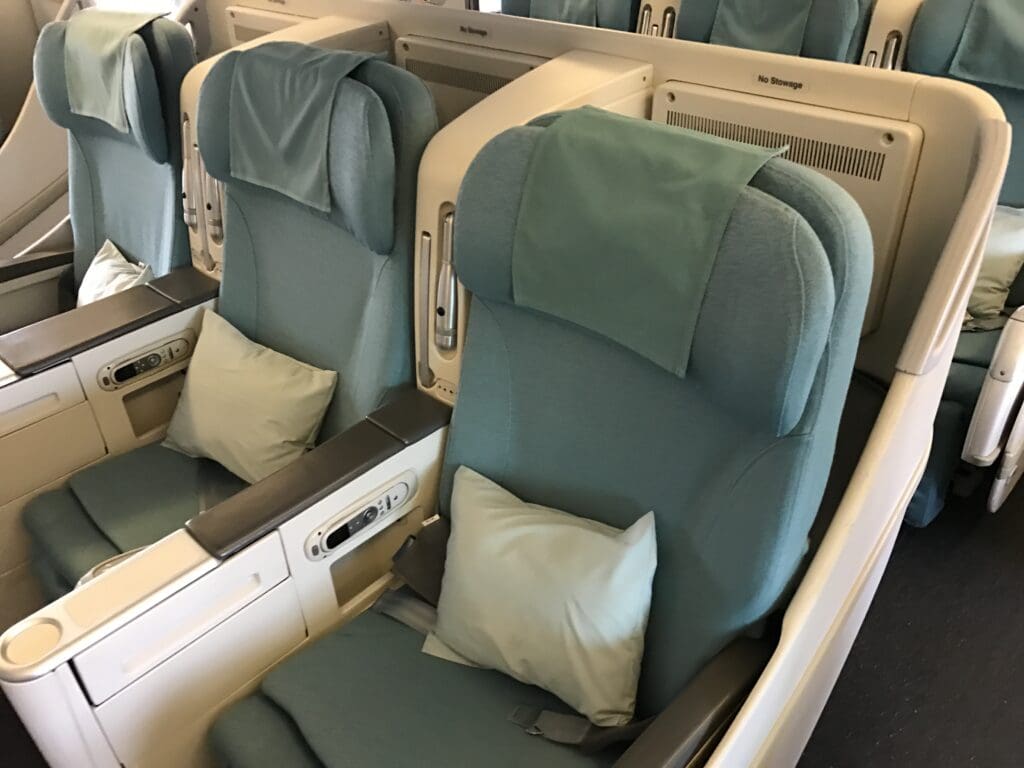
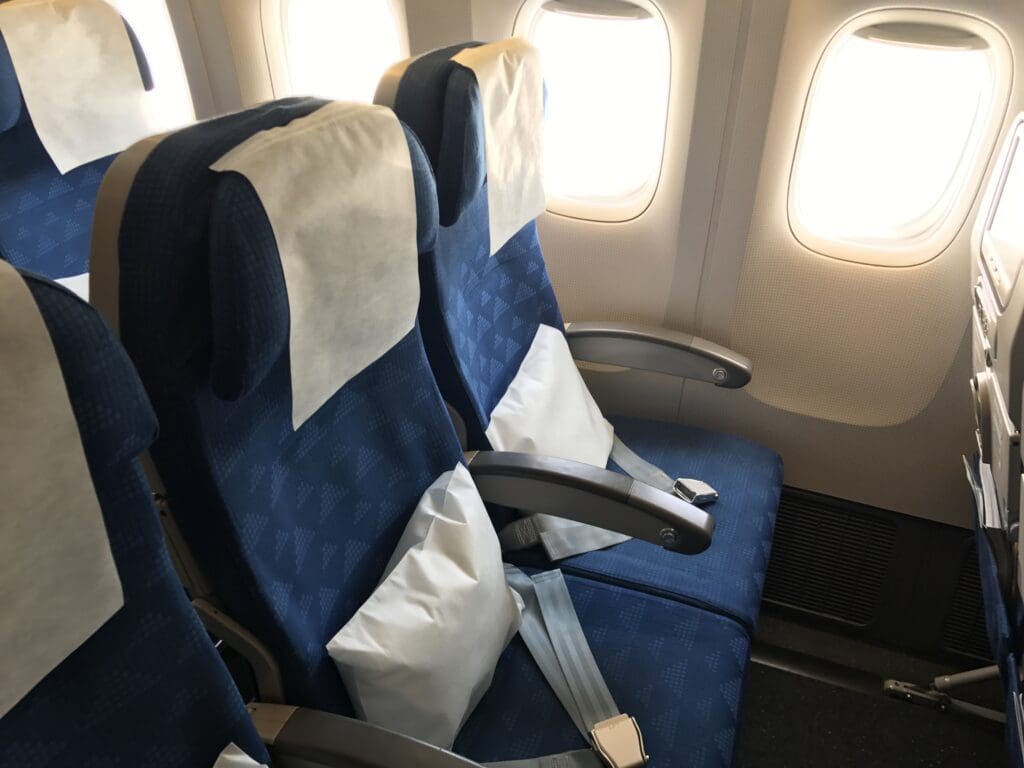
Continuing onwards, I soon arrived in the forward Economy section. In Economy, Korean Air’s Boeing 777-200ERs are configured in the slightly more spacious 3-3-3 arrangement, with each seat coming in the form of the Weber 5751. These are topped with a large adjustable headrest, a coat hook, a bifold tray table, a cup holder, seatback pocket, and a 10.6 inch wide inflight entertainment screen complete with a pull-out controller. Furthermore, each seat features both a universal power outlet and a USB-A port, enabling passengers to charge their devices inflight. Each seat is covered in Korean Air’s somewhat subdued blue and brown fabric covers, which feature a repeating geometric pattern. Unfortunately, other than the cherry blossom depictions on the cabin bulkheads and dividers, this aircraft’s cabin design, like most of Korean Air’s jets, features very little that is distinctively Korean. Much to my delight, despite being one of Korean Air’s shortest international services, pillows had been placed on each seat, whilst the crew readily distributed blankets to those who requested these.
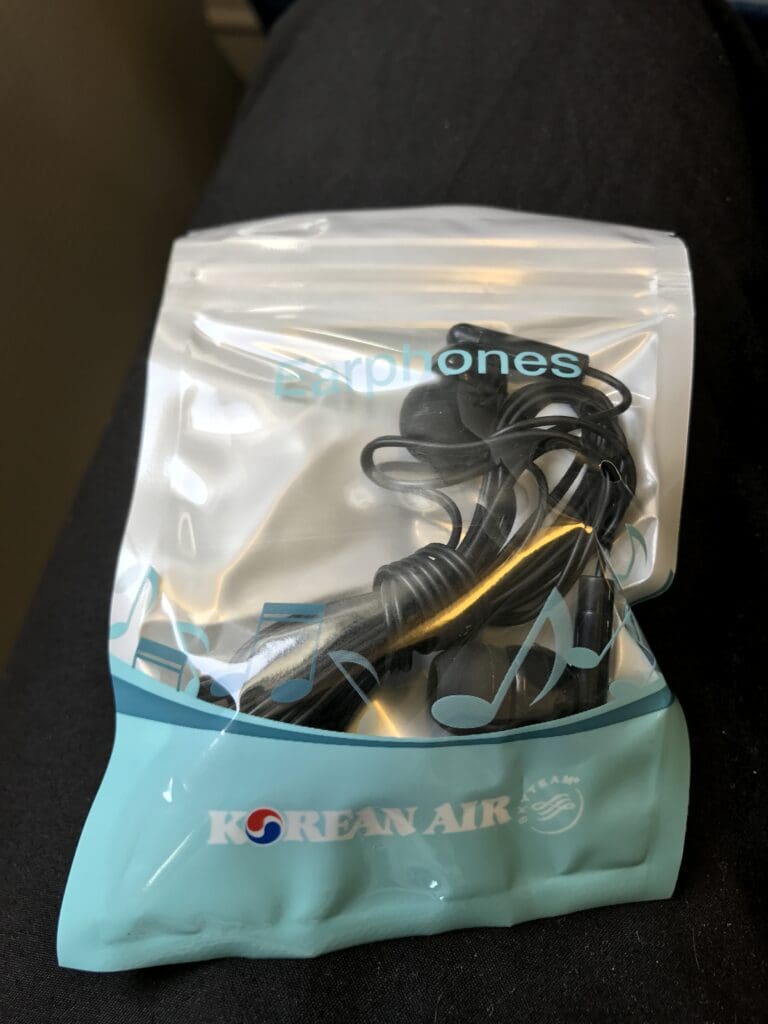
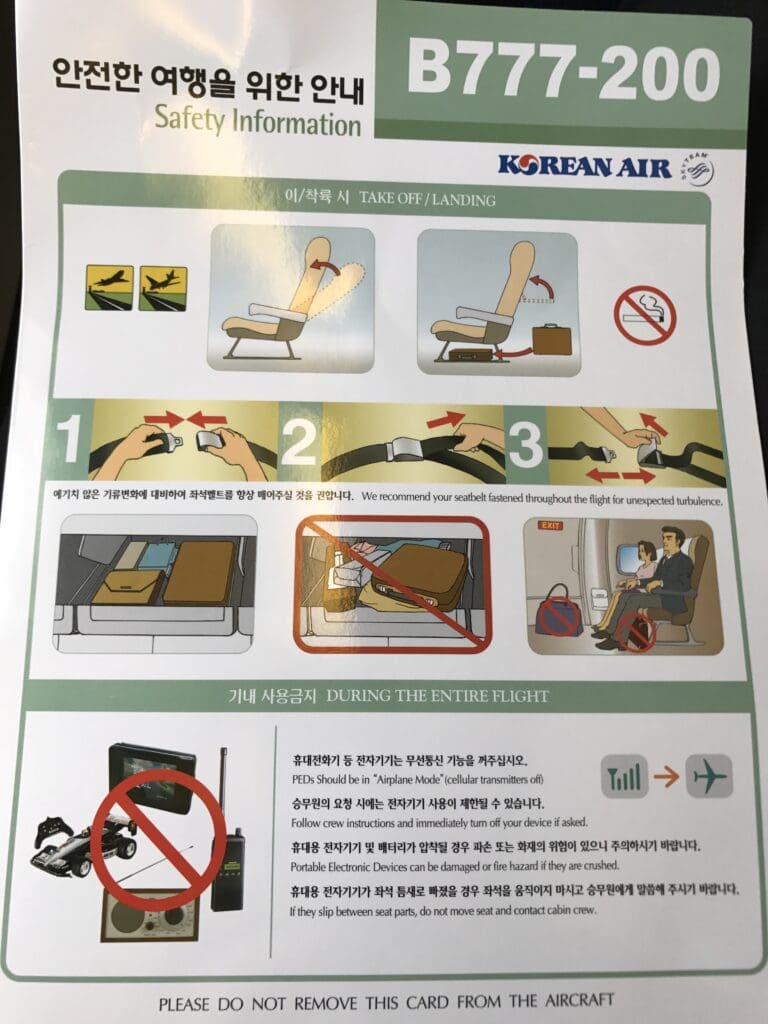
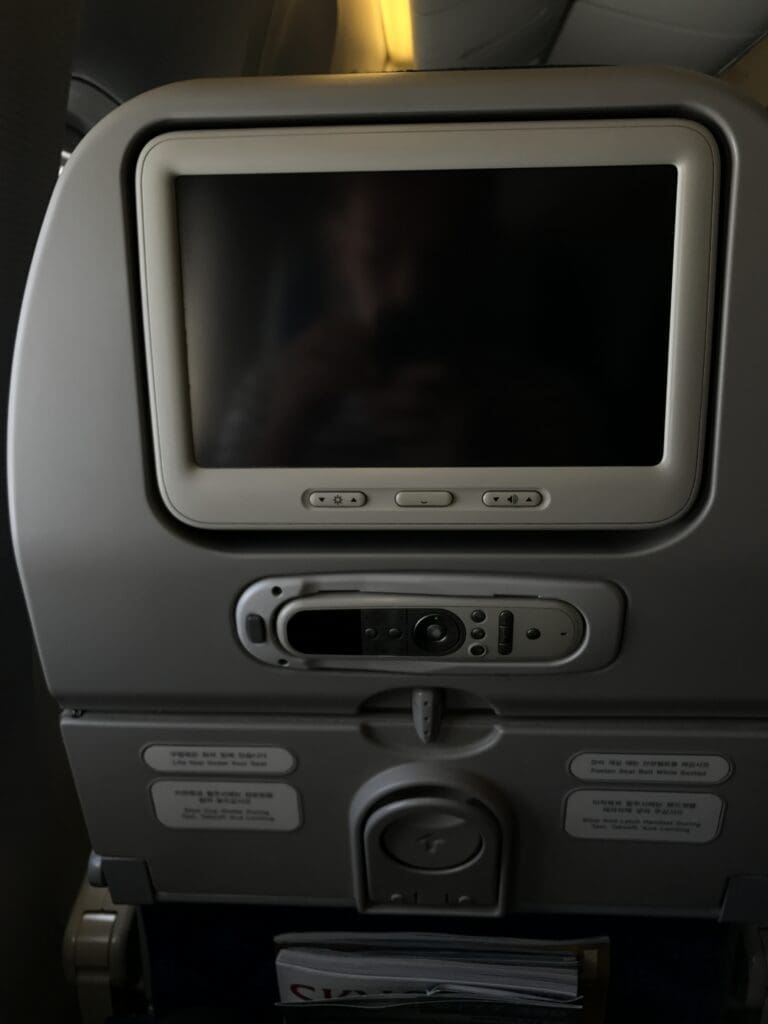
Within a few moments, I arrived at Seat 31A and was pleased to find that I had not yet been joined by any neighbours. Seeing as this was my second flight onboard a Korean Air Boeing 777, I had a good idea of what to expect once onboard, and, as expected, the seat was very soft and highly comfortable, offering an abundance of legroom. Needless to say, I would have been more than happy to fly onboard this jet on a long haul service across the world. Furthermore, the aircraft was spotlessly clean, and the cabin appeared to have been very well maintained, with absolutely no signs of wear and tear anywhere around my seat. During boarding, the inflight entertainment screens remained switched off, although passengers could switch these on and use them whilst still on the ground. Turning to the seatback pocket, this contained the usual safety card and sick bag, as well as the Korea Disease Control and Prevention Agency disease risk area map, a copy of the April 2017 edition of Korean Air’s Morning Calm magazine, a condensed Chinese language version of this which comes as standard on all Korean Air flights to and from China, the Beyond inflight entertainment guide and the latest edition of the Skyshop onboard shopping catalogue.
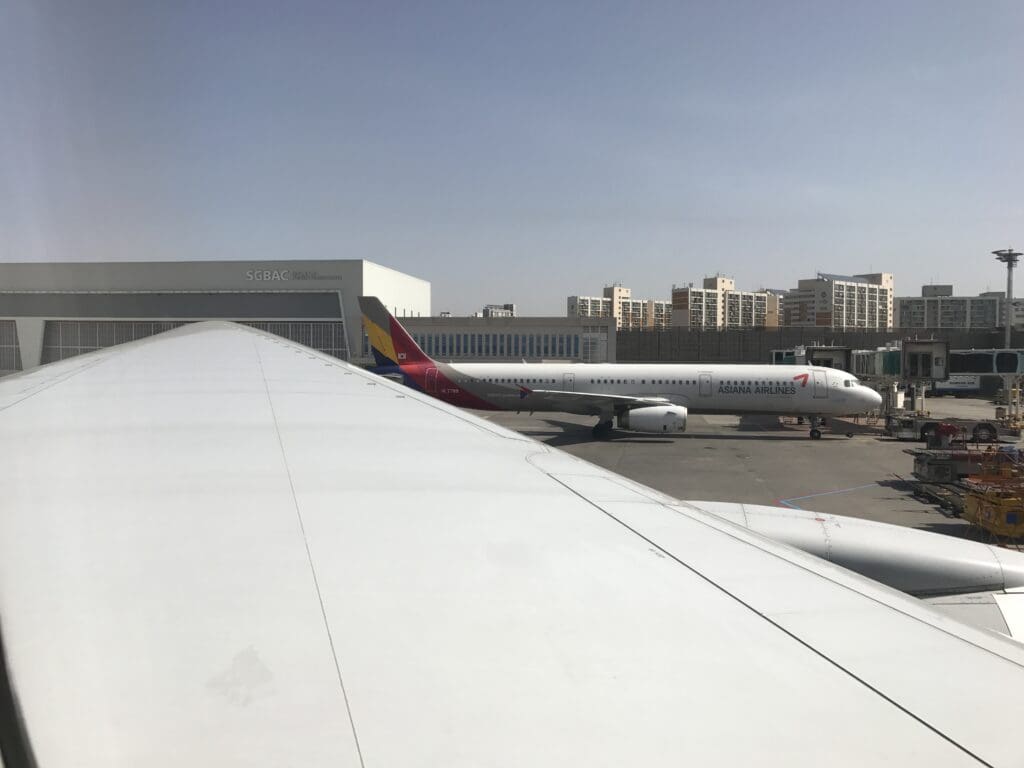
One advantage of the delay was that all cargo had already been loaded onto the aircraft and thus once the final passenger had boarded the aircraft, the cabin doors could be closed and the jet bridges were immediately backed away from the aircraft. Around fifteen minutes after boarding had commenced, the last straggler made it onto the aircraft. That morning, the aircraft appeared to be around half-full in Economy, with many of the passengers onboard taking the form of smartly dressed solo Korean passengers, presumably heading to Beijing for work. Several minutes after boarding had reached its conclusion, the Purser performed their welcome announcement in Korean and English. During this, they offered an apologetic explanation for the delay, which was noted to be due to severe congestion at Beijing Capital Airport, resulting in our slot being pushed back. As with most Korean Air services to and from China, the flight was also staffed by a Mandarin-speaking crew member who repeated each announcement.

As the welcome announcement was being undertaken, crew members took to the aisles and distributed earbud-type headphones, these being different from the over-the-ear type headphones that passengers had been handed on my Korean Air service from Seoul Incheon to Paris CDG several months earlier. However, just like those handed out on the much longer service, I found these to be of typical economy quality and thus, like most of those around me, I ended up using my own headphones during the flight. A short time later, Korean Air’s incredibly dated safety video took over each and every inflight entertainment screen, with this being played in Korean and Mandarin with English subtitles.
Somewhat worryingly, at 1050 I watched as a single jet bridge was manoeuvred into position, hinting that we would be subject to a further delay. Presumably missing some vital paperwork, a few minutes later this was backed away and at 1055 the aircraft was pushed back away from its parking position. As we began to move, no engine noise could be heard, and whilst this was not initially too much of a concern, it soon became evident that we were not departing but instead simply being positioned to a remote stand on the other side of the apron. A short time later, the Boeing came to a halt at Stand 231.
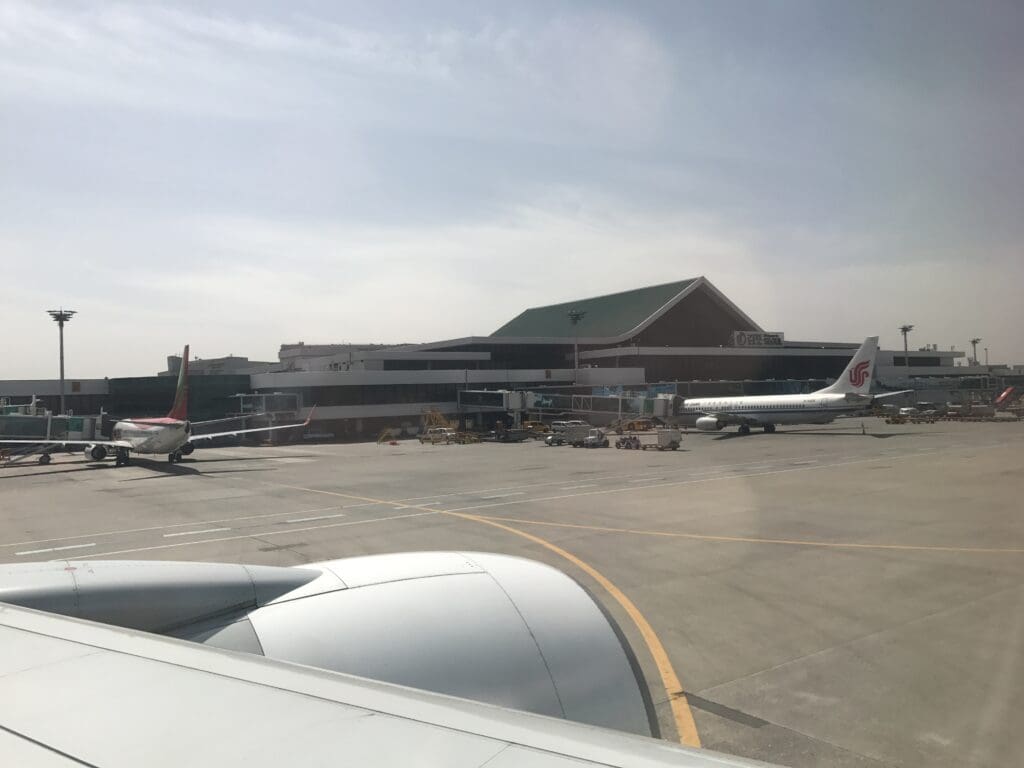
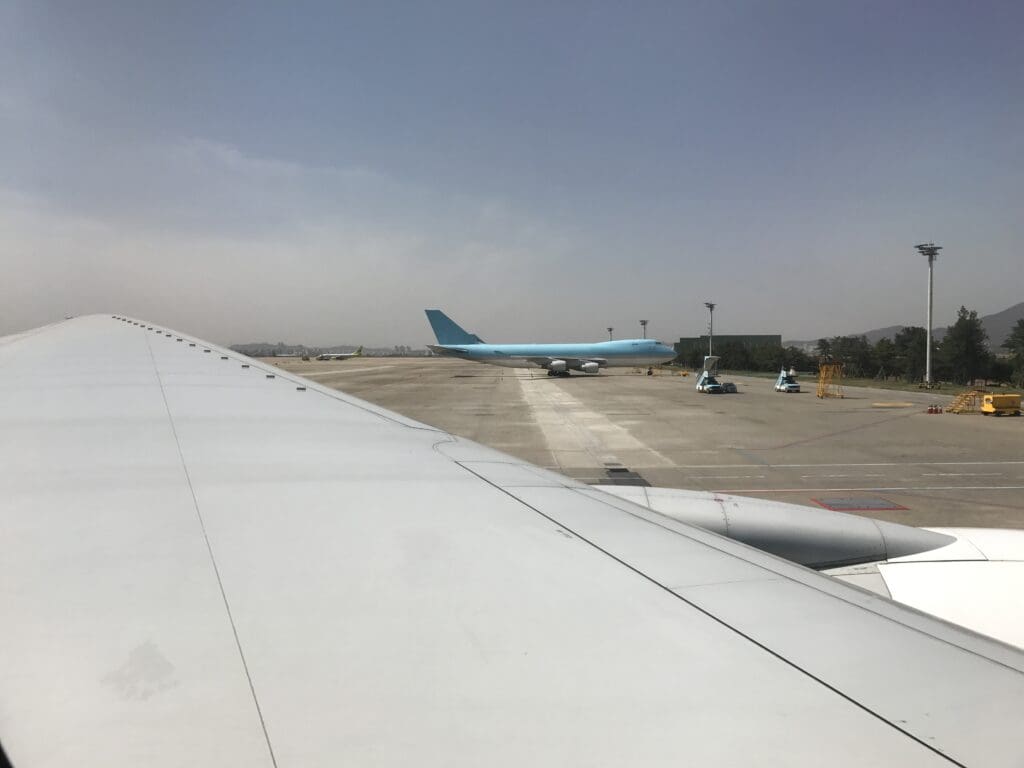
Explaining the situation, once we had arrived at the remote stand, the Captain performed an announcement in Korean and English. During this, they apologised for the delay and explained that this had been due to exceptionally high traffic levels at Beijing Capital Airport. They then noted that whilst we had been ready to depart, at the very last minute Chinese air traffic control had requested that our departure be delayed by a further 25 minutes and, as an arriving aircraft needed to use our gate, we would have to wait at a remote stand. Indeed, looking outside a sleek Japan Airlines Boeing 787-8 Dreamliner could soon be seen pulling into Stand 38 at the end of its morning flight from Tokyo Haneda Airport. Whilst this was far from an ideal situation, especially considering my connection in Beijing, onboard, the cabin crew seemed to handle the delay quite well. Once at our remote stand, the seatbelt signs were extinguished and passengers were free to move around the aircraft and use the onboard bathrooms. Furthermore, the crew soon passed around distributing cups of water. Hoping to move to get a less obstructed view of the world outside, I was given permission to move seats and I opted to take Seat 50A in the almost entirely empty rear Economy cabin. Once settled into my new seat, I was a little concerned to see that a set of airstairs had been brought up to the aircraft alongside a bus, giving the impression that passengers may be asked to disembark.
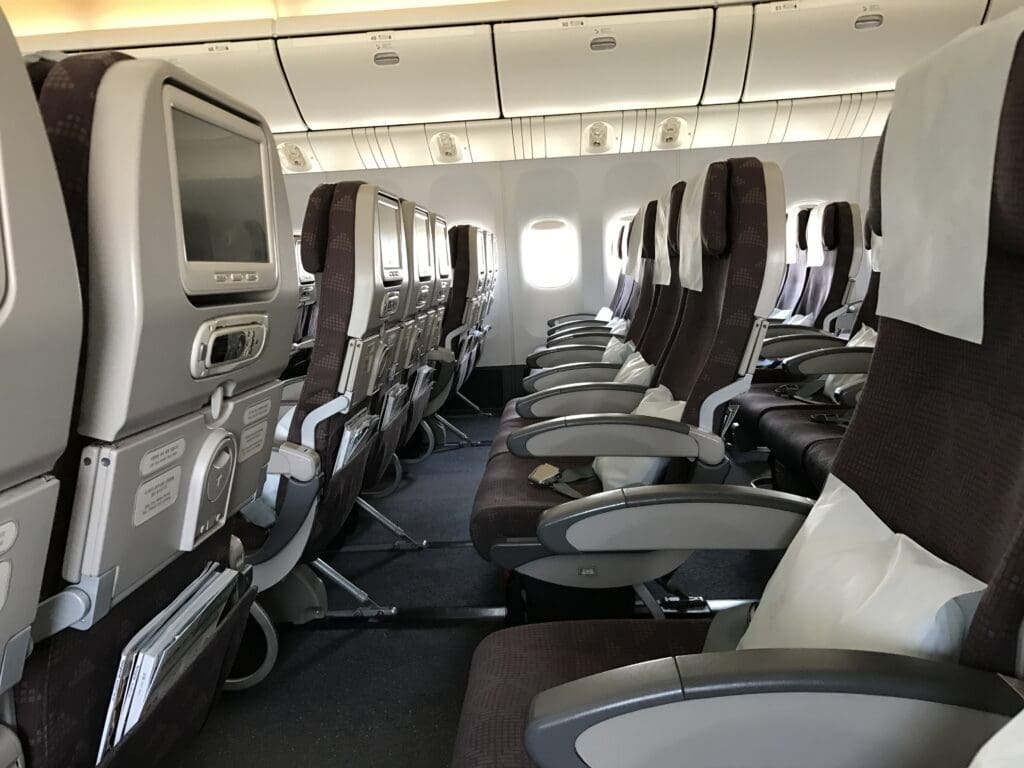
Fortunately, this turned out not to be the case and after a long delay, at 1116, the aircraft was pushed back for a second time. This time, the aircraft’s two massive Pratt & Whitney PW4090 engines powered into life, temporarily creating much noise and vibration. Exactly two hours after we had been scheduled to depart Seoul, at 1120 the aircraft powered away from the apron under its own steam and began its journey to the end of Runway 32R. This took us past two sleek Gulfstreams, the crowded domestic terminal and Asiana Airlines and Korean Air’s maintenance areas before we arrived at the end of the runway.
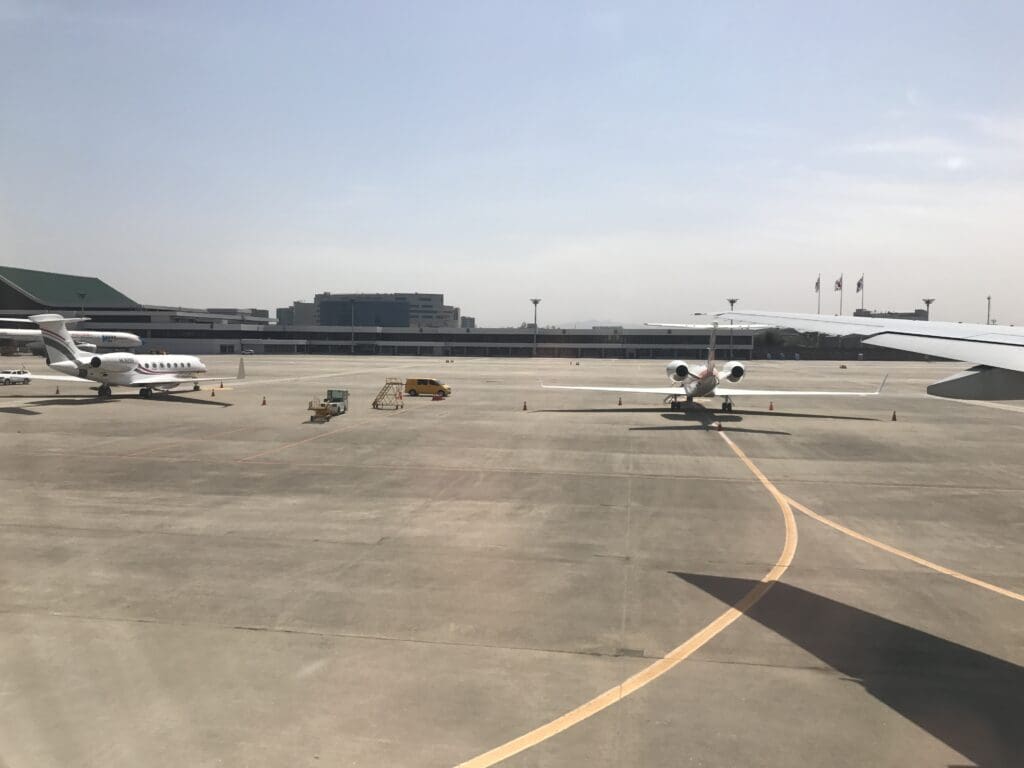
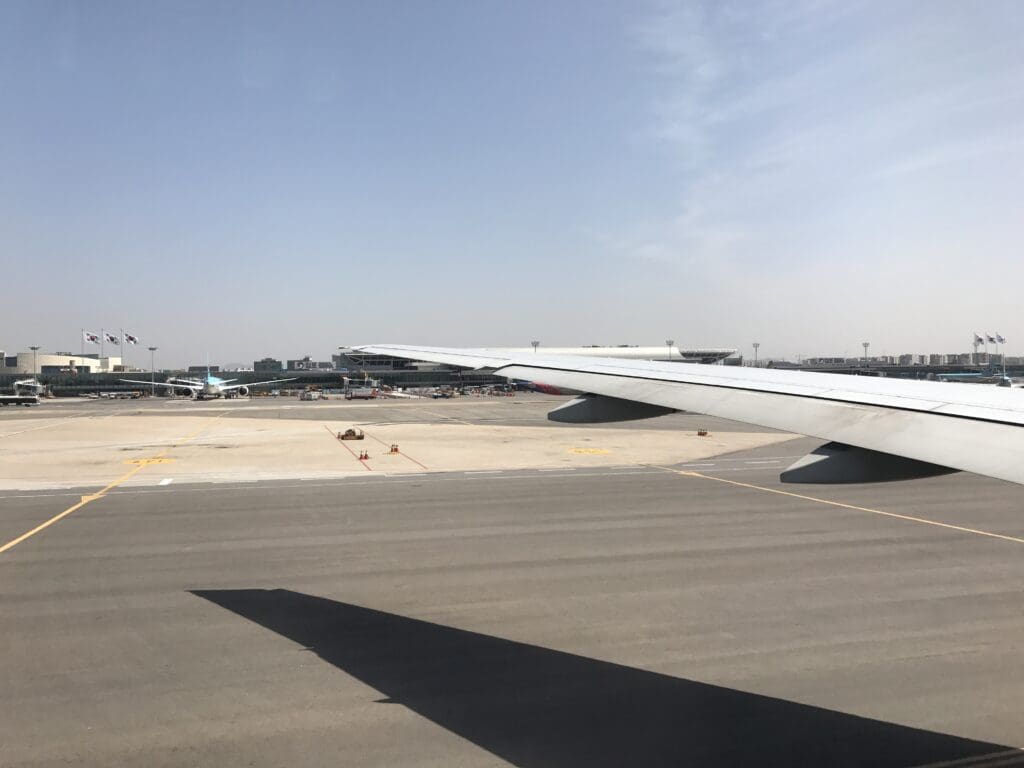
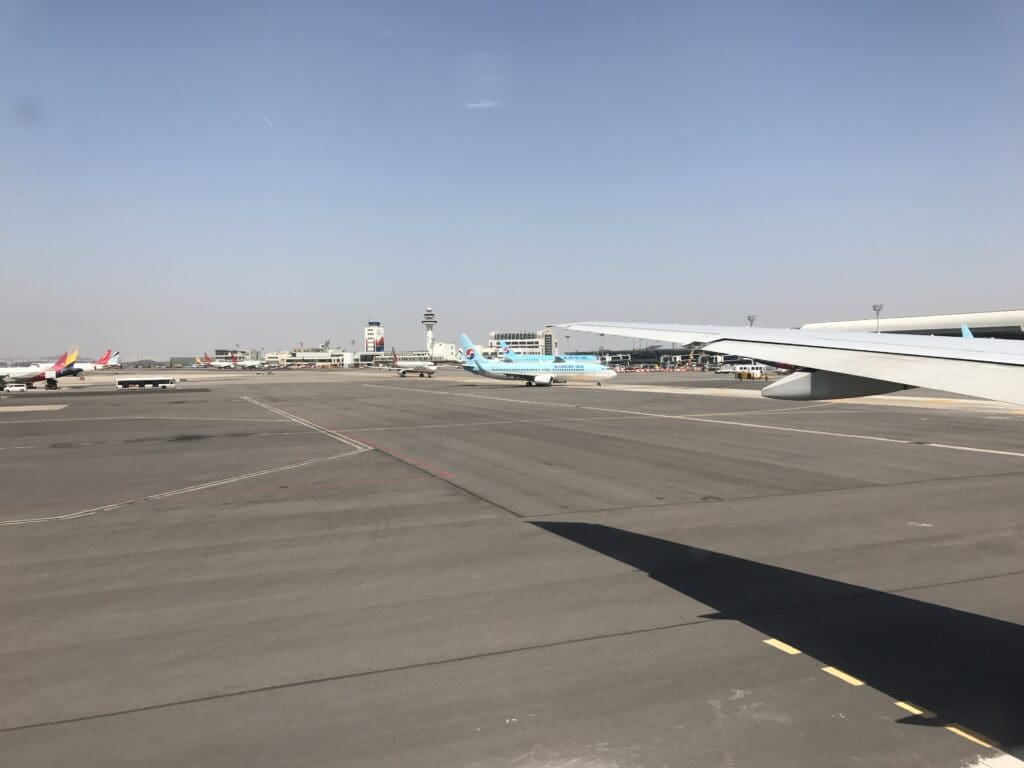
Following a short hold, at 1131, the Boeing 777 lumbered onto the runway and held for a few moments in order to allow for an Asiana Airlines Airbus A321 to touchdown from Jeju on the parallel runway. Once this Airbus was safely down and it could be confirmed that the jet would not be commencing a go around, the Boeing commenced a noisy and unsurprisingly powerful take-off roll. Flying down the runway, a good view of the line of hangars on the south side of the airfield could be seen, with this being home to all manner of aircraft ranging in size from Cessna 152s up to the Korean Coast Guard’s Bombardier Challengers and CASA 235 surveillance aircraft. In no time at all, the Boeing made a sporty rotation into the clear Korean skies, soon leaving Seoul Gimpo International Airport behind.
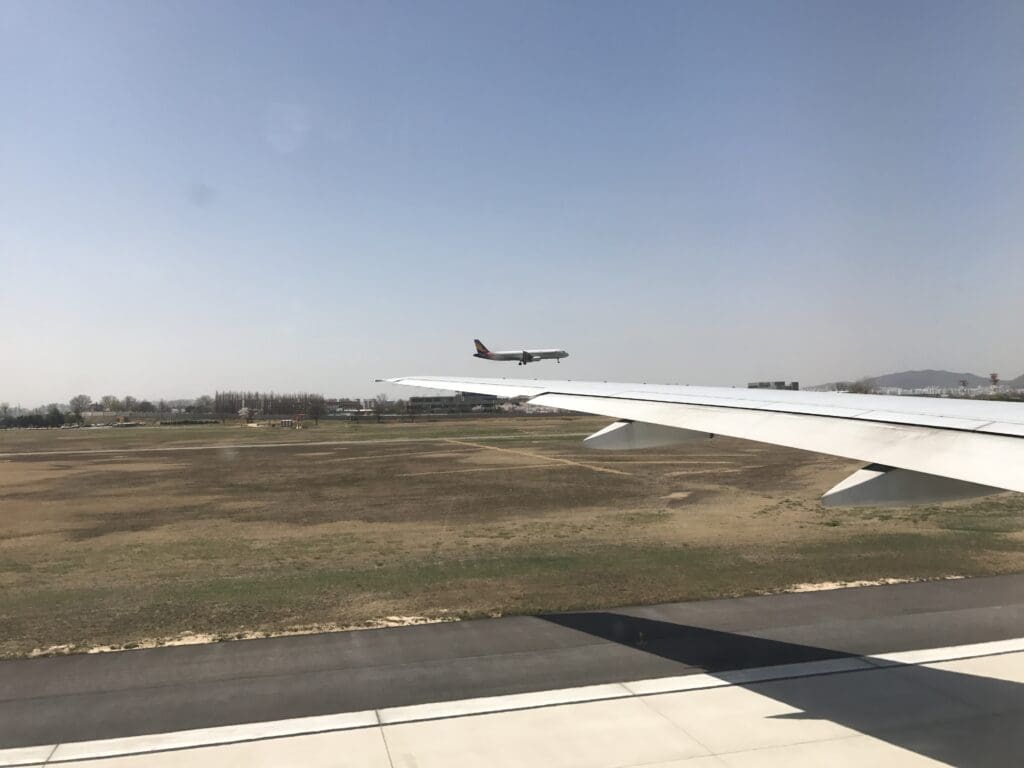
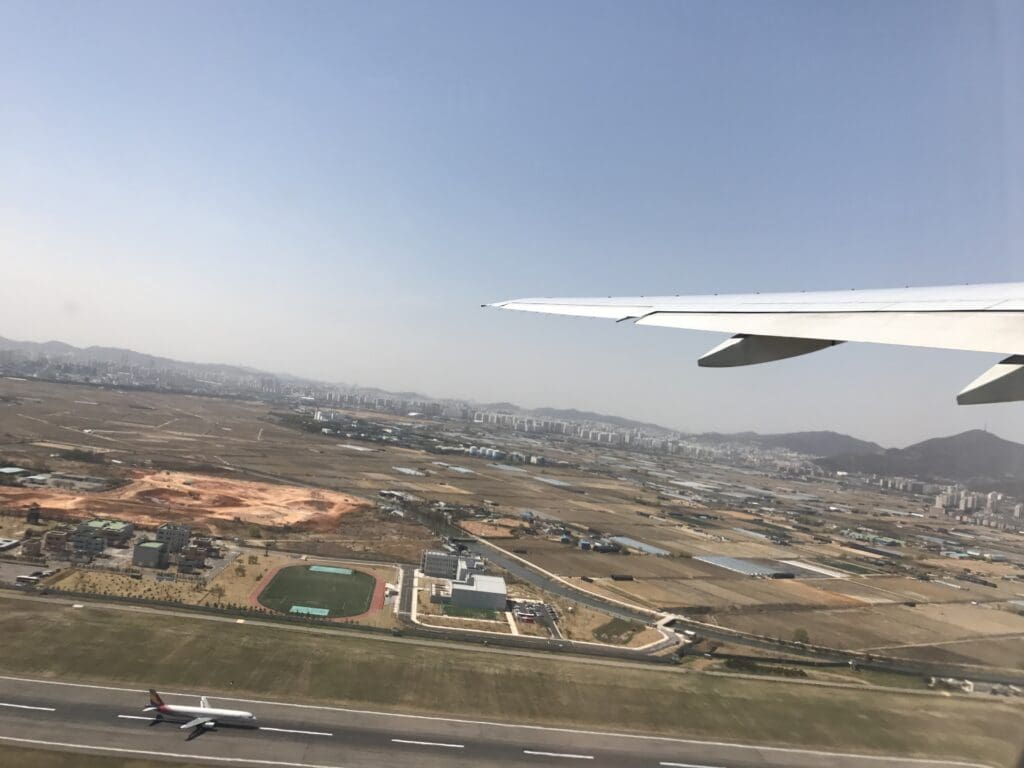
From the airport, the aircraft flew roughly parallel to the southern banks of the Han River and thanks to the clear conditions, those on the opposite side of the aircraft would have been treated to superb views of the mountains of Seoul’s Bukhansan National Park, followed a short time later by Ganghwa Island and the border with North Korea. However, the views from my seat on the left-hand side of the aircraft were slightly less varied, with the sprawl of Korea’s third-largest city, Incheon, appearing a short time after taking off.
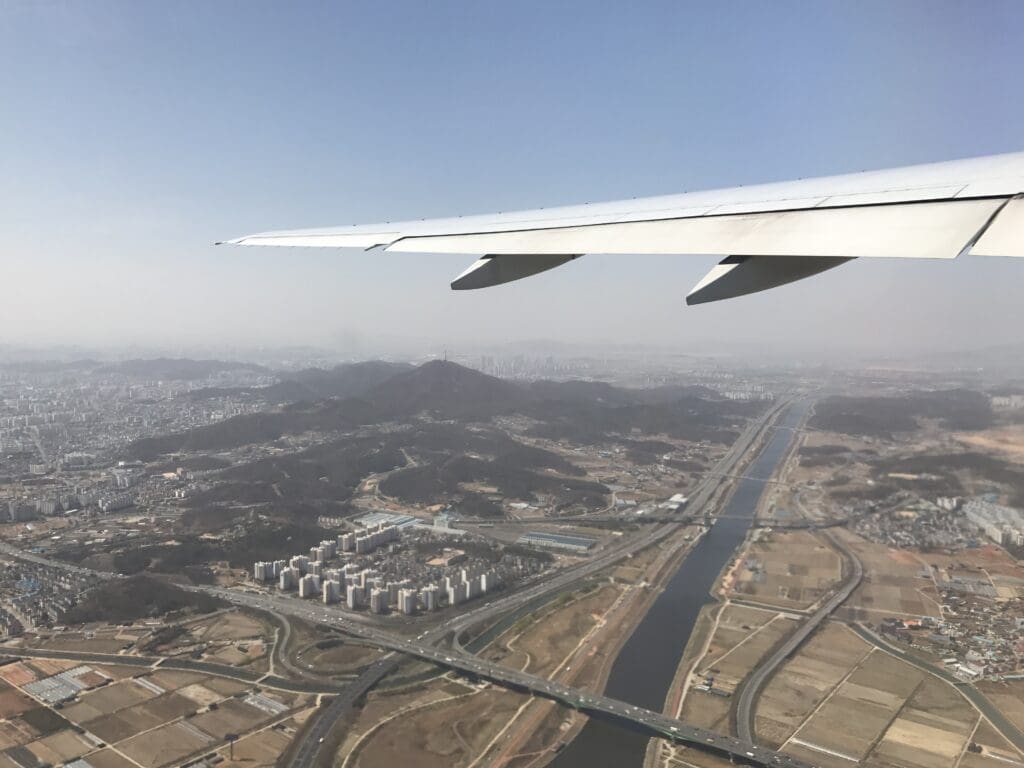

Making a powerful climb, the aircraft reached 10,000 feet as it reached the shores of Yeongjong Island and passed high above Seoul Incheon Airport. At this point, the seatbelt signs were extinguished and the usual announcement advising passengers to keep these fastened whilst seated was made in Korean, English and Mandarin. As is the norm on Korean Air, this was accompanied by messages warning passengers against smoking, and abusing or harassing the crew onboard.
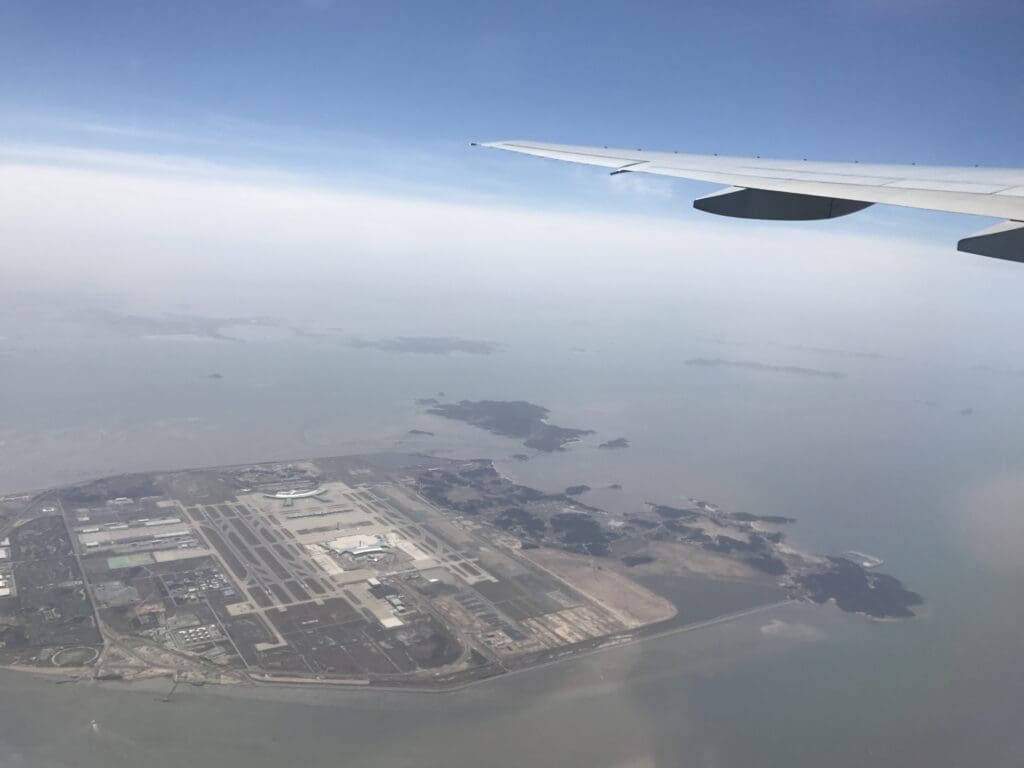
After enjoying superb views of Seoul Incheon Airport below, Yeongjong Island faded away at which point I decided to play around with the Beyond inflight entertainment system. Starting with the positives, this was quick to load and laid out in a fairly basic manner, making it easy and straightforward to navigate. Examining the content, this offered an acceptable selection of films, television programmes and music, the majority of which was from either Korea or the USA. However, as I have noticed on my other flights with Korean Air, I was a little disappointed at the lack of Korean films, with just four of these available on the system. Ending on a positive note, as is always a pleasure to see, content commenced without any advertisements being played.
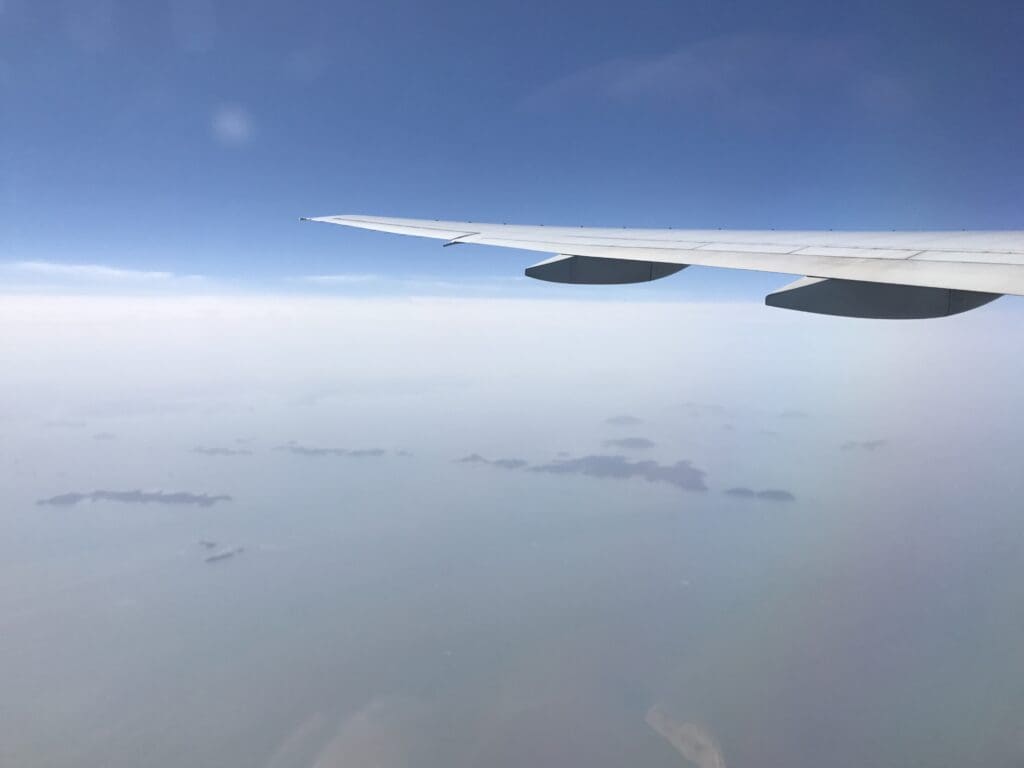
As the Boeing levelled off at 32,000 feet, the Captain undertook their second announcement of the flight. During this, they gave an update on our cruising altitude, route to Beijing and the weather on the ground in the Chinese capital. Importantly, they noted that we could expect to touch down on Chinese soil at 1220 Beijing time. With this being just 35 minutes before my flight to Urumqi was scheduled to depart, I fully expected that I would be unable to make this connection. Aware of the fact that China Southern Airlines operates plenty of services between Beijing Capital Airport and Urumqi every day, I was hopeful that I would simply be moved to the next departure.
Once the aircraft had settled at its cruising altitude, the flight attendants took to the aisles and the meal service commenced. Thanks to the lack of passengers, this was a fairly quick affair and I was soon approached by two very polite and friendly flight attendants. With no choice available, the morning meal was handed over to me and placed on my extended tray table before I was offered a drink. This consisted of a main dish of pork bulgogi with rice, which was accompanied by a mozzarella salad, a bread roll with butter, a slice of pineapple and a tub of parent company Hanjin’s Jeju Purewater. Meanwhile, an array of hot and cold, and hard and soft drinks were on offer. Adding a touch of sophistication, eating utensils came in the form of real metal cutlery on which Korean Air’s taeguk-inspired motif had been ingrained. Soon getting to work, I found the quality of the meal to be very good, with the meat being sufficiently sweet and not too fatty, whilst the rice had just the right texture and the salad seemed to be nice and fresh. Furthermore, this offering was far more than you would expect to receive on a flight of a similar length back home in Europe! To top it all off, my tray was removed as soon as one of the cabin crew members noticed that I had finished eating.
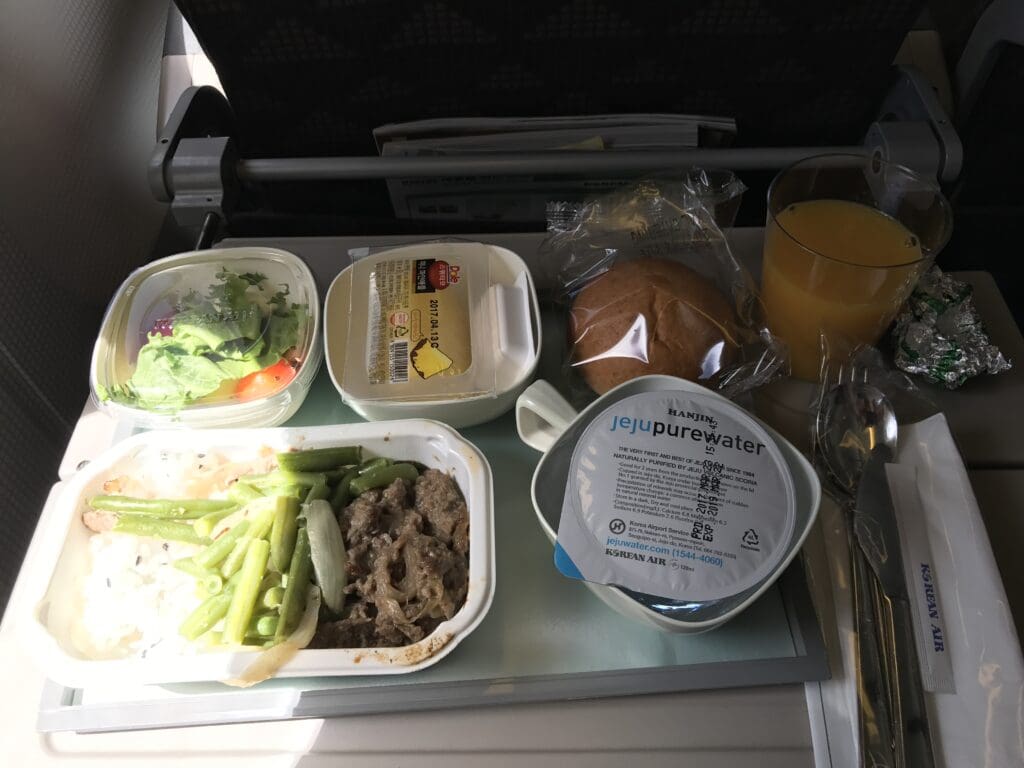
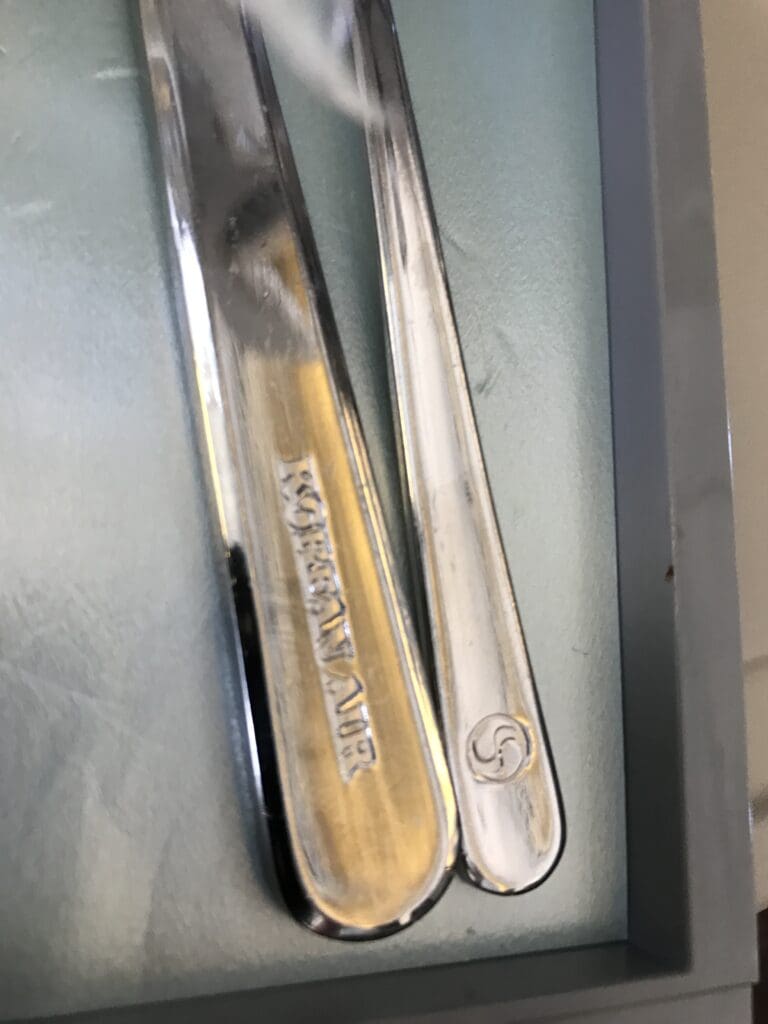
Once the last of the Korean islands slipped away from view, little could be seen below aside from the occasional cargo ship until the cluster of inhabited islands in the Strait of Bohai appeared below. These soon disappeared and little could be seen until the Chinese mainland appeared through the haze around 25 minutes later. Following our journey over the Yellow Sea, the Boeing made landfall near the massive city of Tianjin, well known for its sprawling port. At this point, realising that the aircraft would soon commence its descent, I decided to pay a quick visit to one of the lavatories at the rear of the aircraft. In total, there are seven lavatories available in Economy class – three that sit in between the two Economy cabins, with a further four at the rear of the aircraft. With 32 passengers per lavatory, this is one of the lowest ratios on a widebody aircraft that I have ever encountered! Having perhaps remained unused during the flight, this was spotlessly clean and stocked with all the basics, leaving me with no complaints whatsoever.
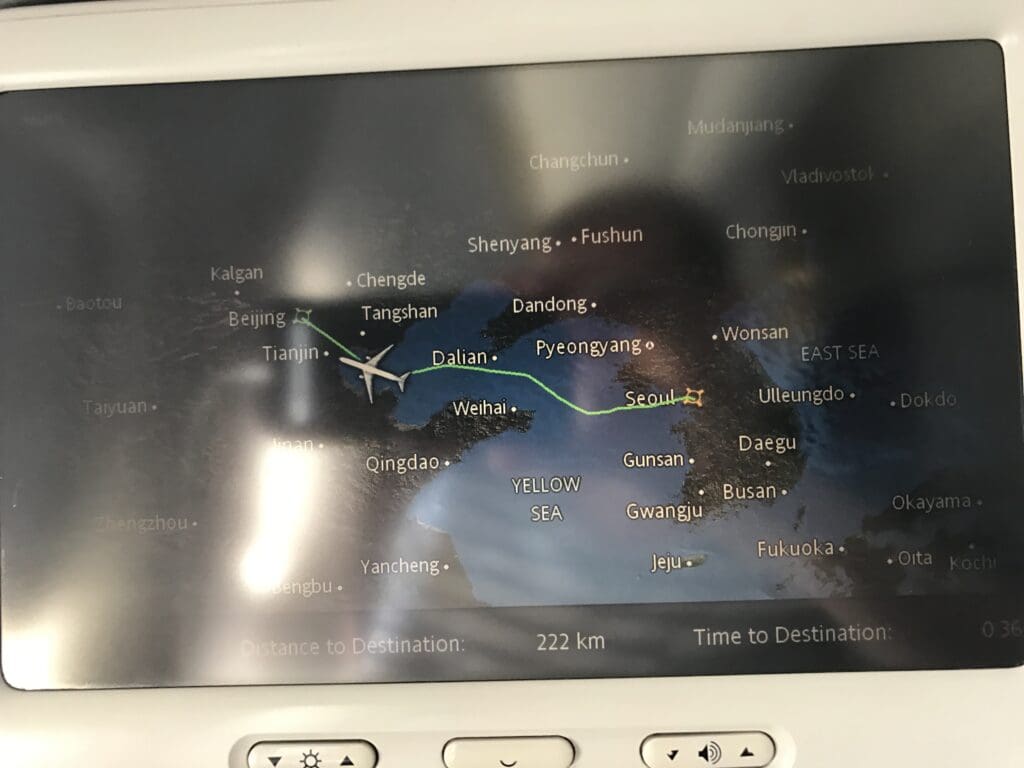
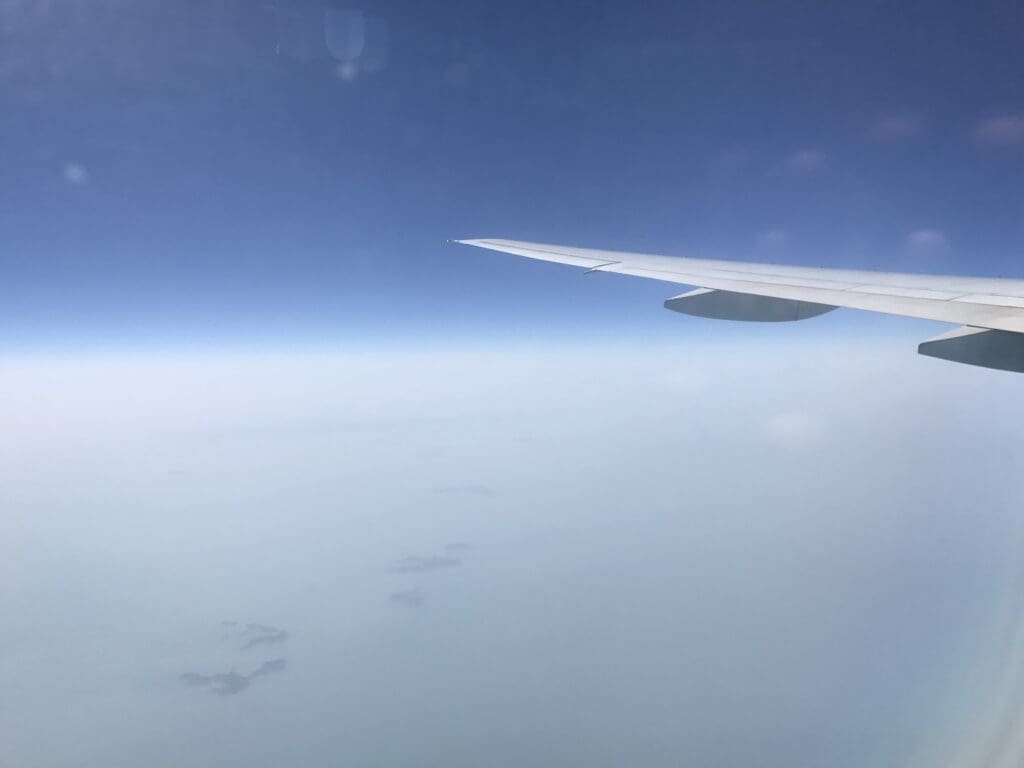
By the time I returned to my seat, the aircraft had commenced its descent towards Beijing and soon levelled off at 17,000 feet. At this point, the seatbelt signs were reilluminated and the crew performed their pre-arrival announcement in Korean, English and Mandarin before passing through the cabin ensuring all was in place for our arrival. As the aircraft neared Beijing, the haze and smog that had partially obscured views of Tianjin partially cleared allowing for some half-decent views of the industrial and residential areas surrounding China’s capital city.
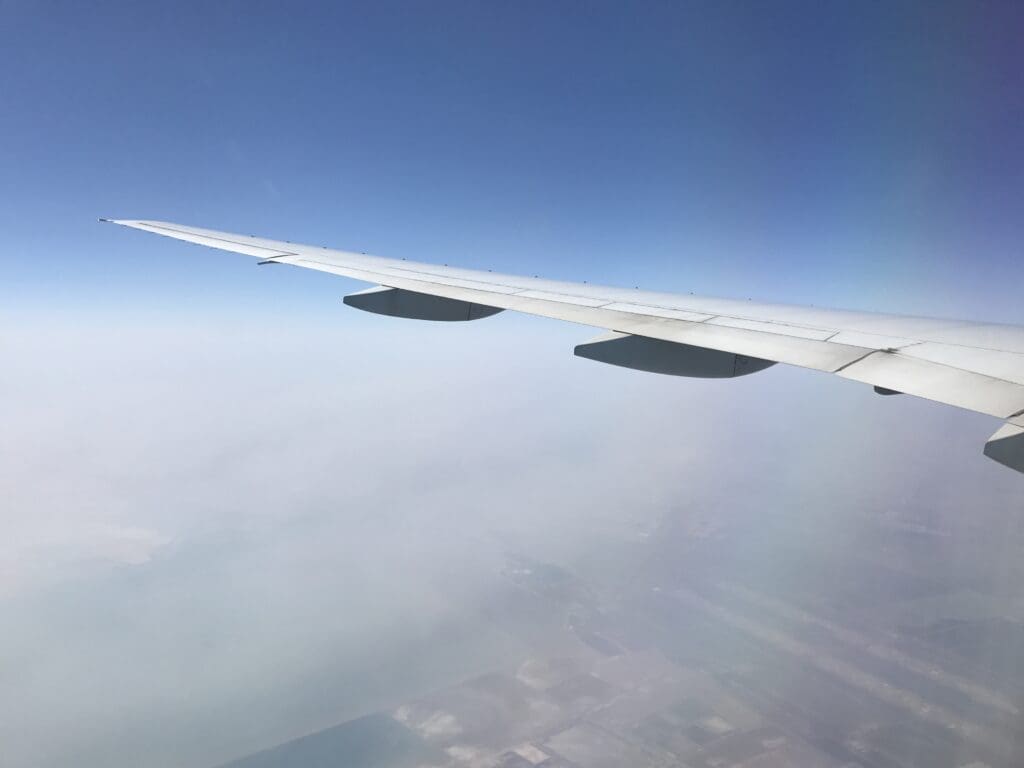

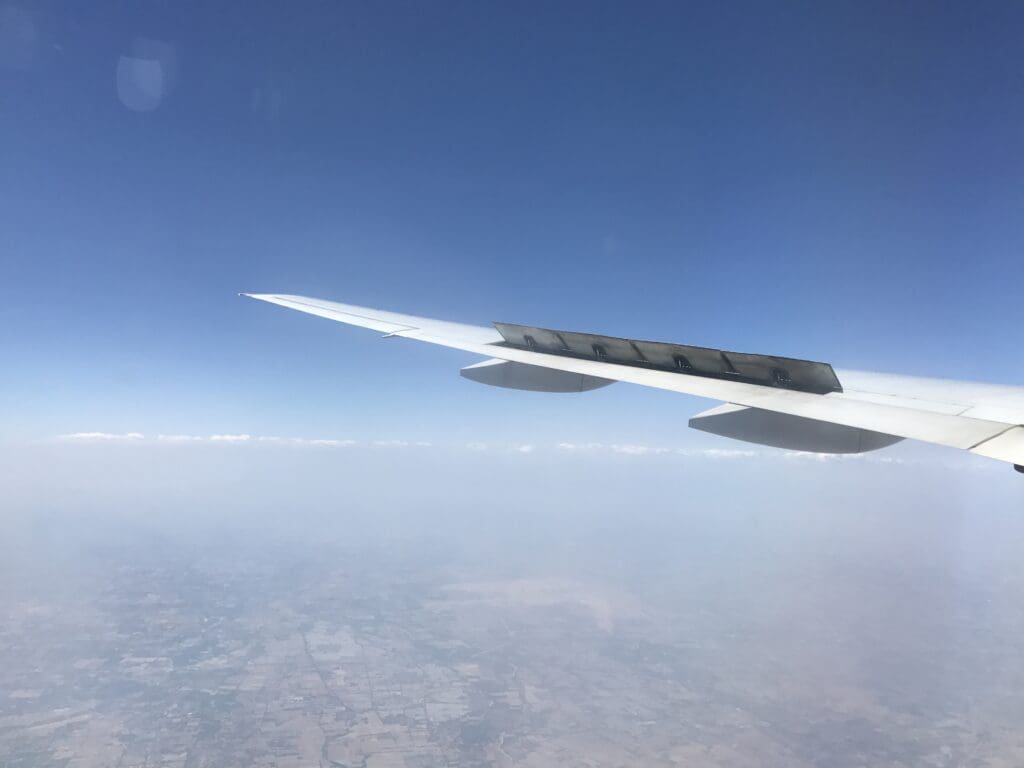
Eventually, the aircraft left 17,000 feet and continued its descent, with the seemingly endless sprawl of Beijing Capital Airport soon appearing as we entered the downwind leg of our approach. After flying past the airport, the Boeing continued for quite some way before making a 180-degree turn, at which point the flaps and gear were extended in preparation for landing.
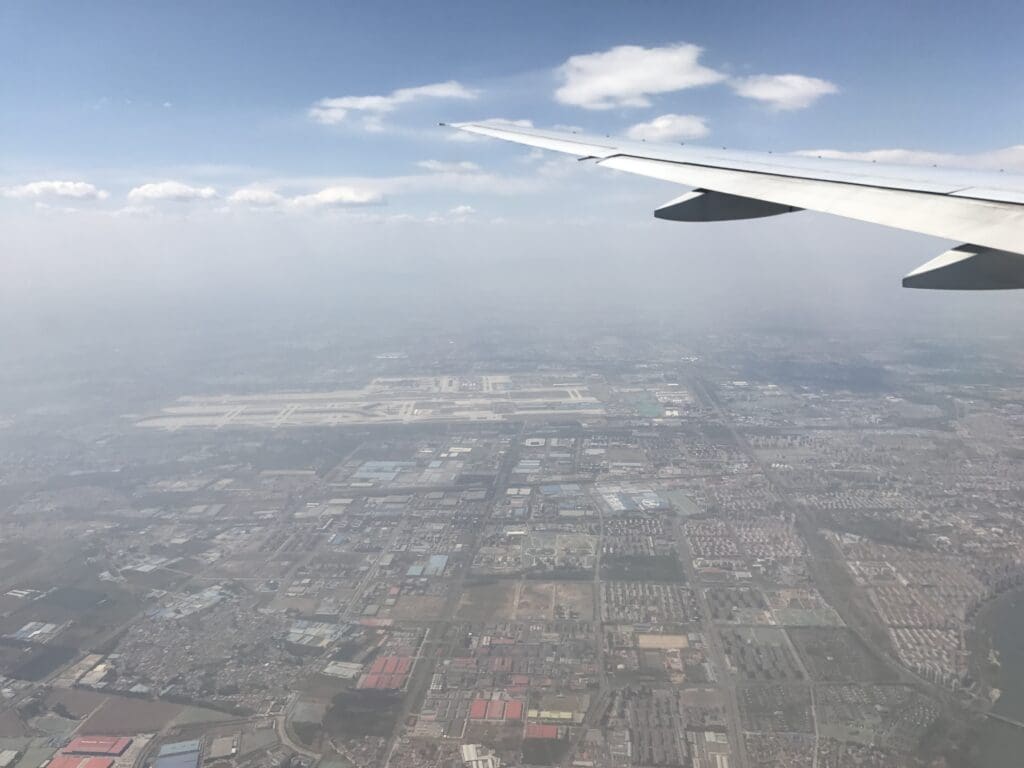
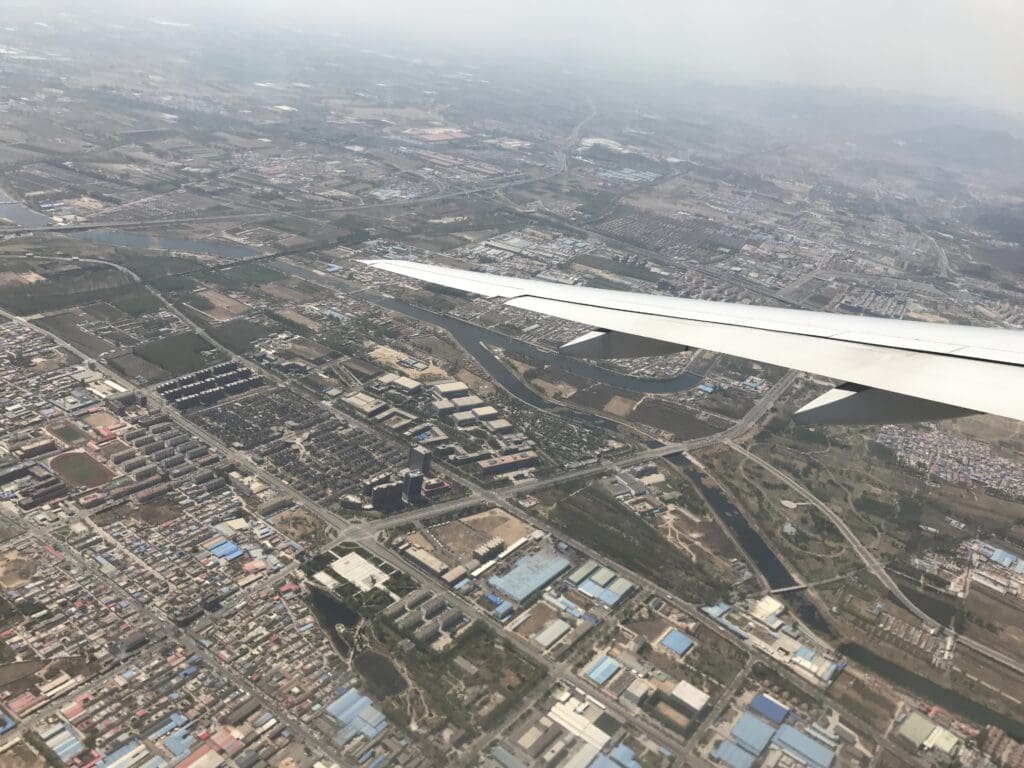
Once pointing in the direction of the airport, the Boeing made a smooth descent over rows and rows of industrial estates and factories before eventually reaching the airport’s well-guarded perimeter. At 1221, 01:48 after taking to the skies of Korea, the Boeing returned to Earth with a very firm bump on Runway 18R which was followed by some rather harsh braking. Whilst our arrival was perhaps a little uncomfortable for some, this quick deceleration ensured that we would be in for nothing more than a short taxi over to Beijing’s SkyTeam hub at Terminal 2 – something that often seems to be a rare luxury in Beijing!
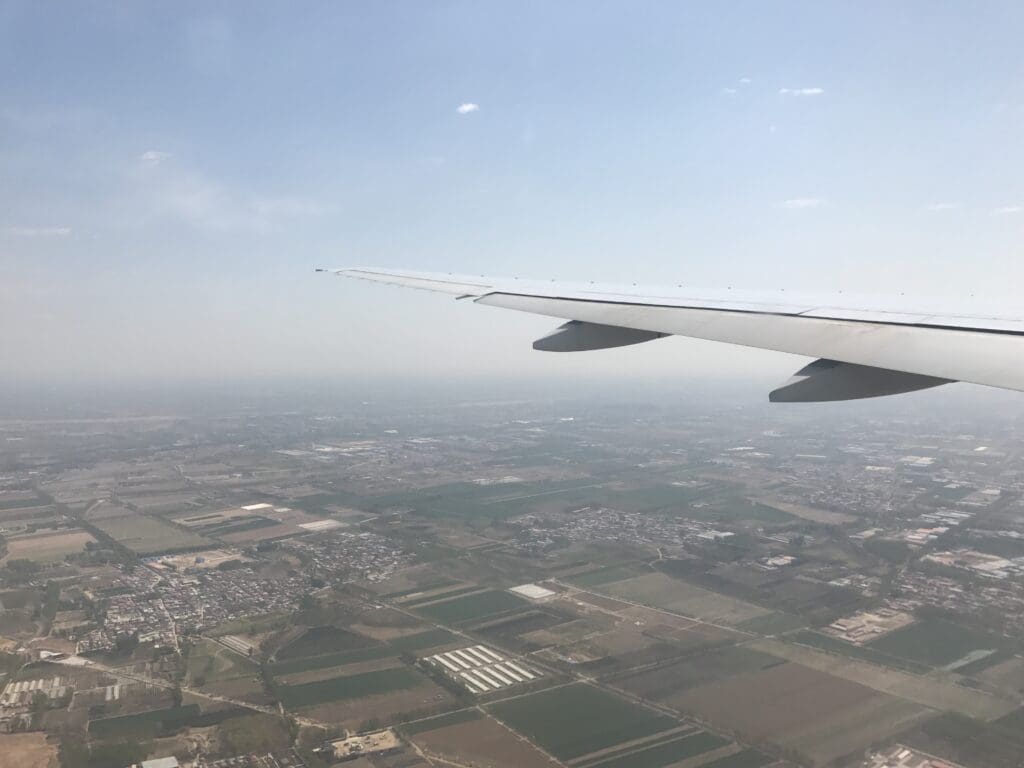

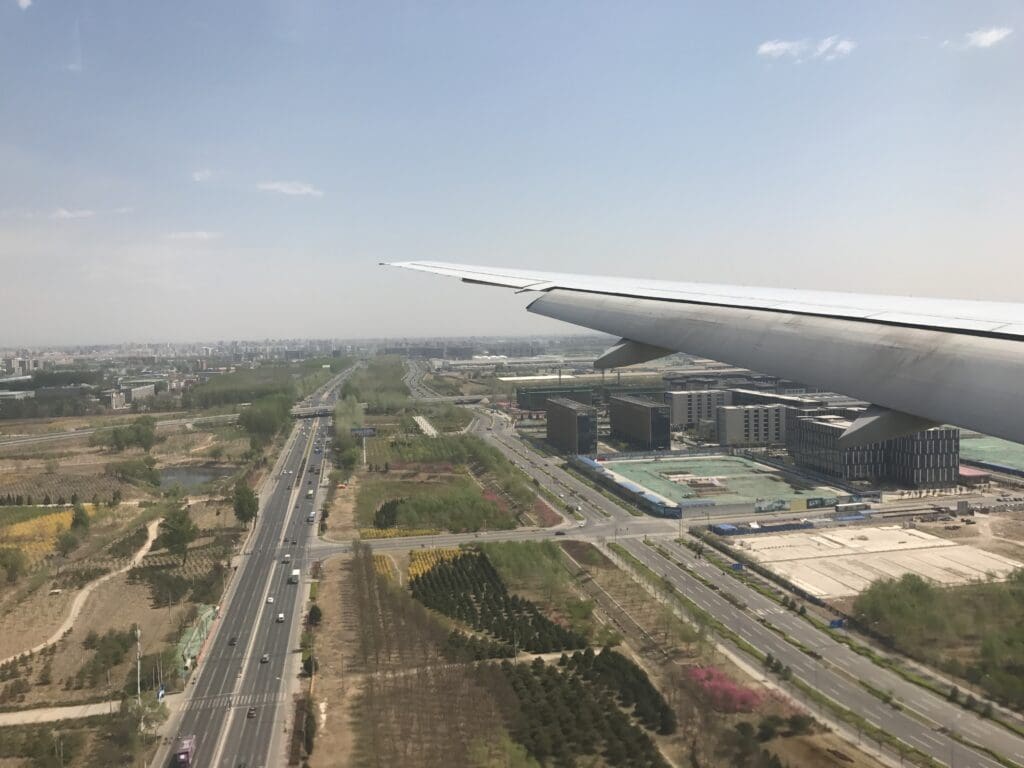
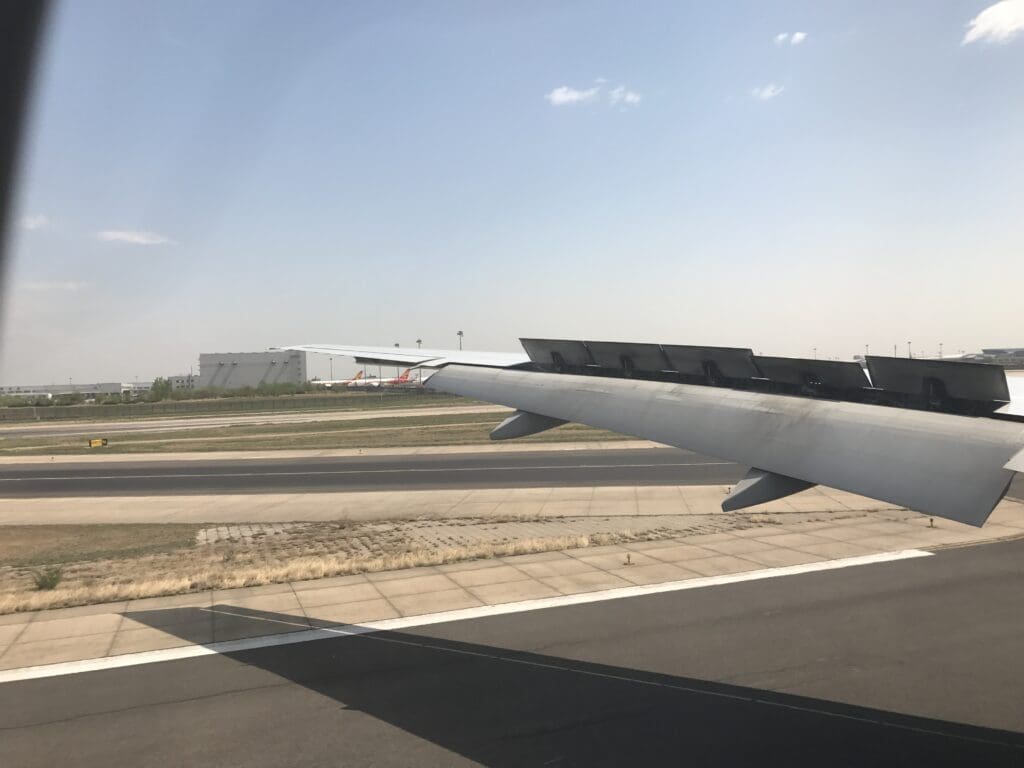
Following a quick six-minute taxi, the aircraft pulled into Stand 208 at the terminal where our engines spooled down. Fortunately, there was no chaotic rush to disembark, and, knowing that I had almost certainly missed my onward connection, I too was not in any particular rush. With things running like clockwork, the jet bridge was soon connected and disembarkation commenced. Making my way through the cabin, I thanked the flight attendants that I passed and received a polite and friendly farewell before stepping off the aircraft and entering the warm jetbridge.
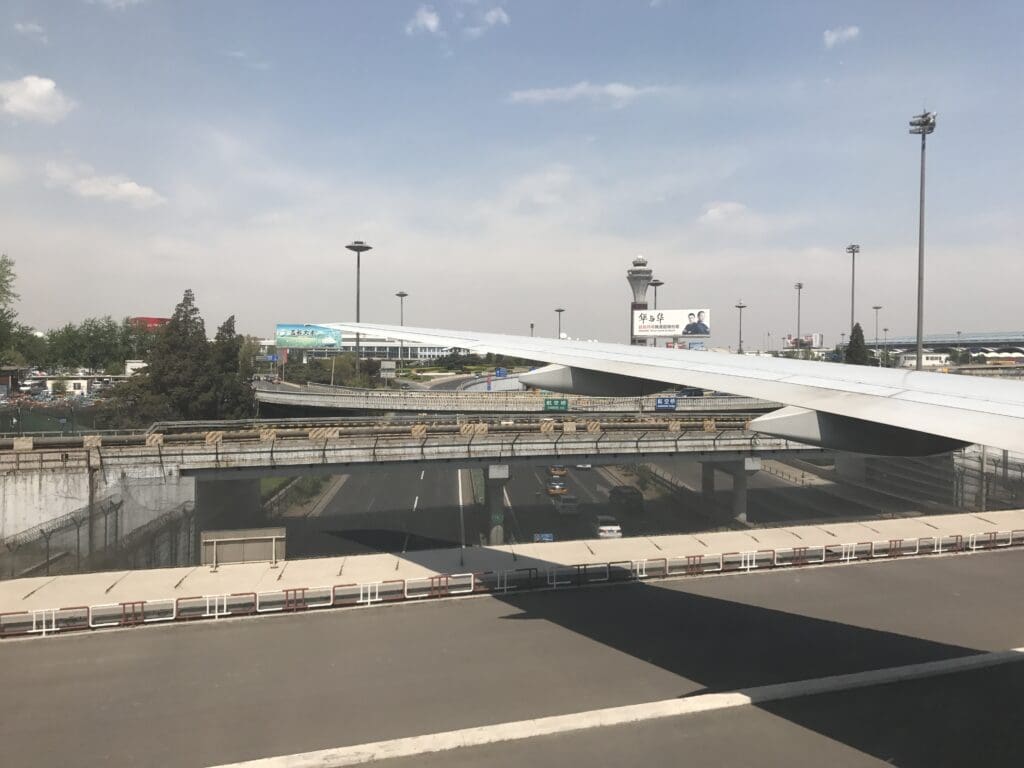
Much to my delight, seconds after stepping off the aircraft, I caught sight of a Korean Air staff member holding a sign reading Urumqi/Dubai and Guangzhou/Sydney. Once I had made myself known to this friendly staff member, as I had expected, I was told that I was going to miss my onward connection to Urumqi and thus my ticket needed to be rebooked. Meanwhile, those passengers bound for Australia were a little luckier and ended up being escorted through the terminal so as to ensure they did not miss their onward flight.
Summary
Once onboard, I was left with absolutely no major complaints about my Korean Air experience – the aircraft was spotless, spacious and comfortable, the crew were very polite and friendly, and the catering was superb given the short length of the flight between Seoul and Beijing. Meanwhile, credit ought to be given to the crew for keeping us updated and informed regarding the delay. However, like many trip reports, I can’t deny that Korean Air could have definitely offered more content on their inflight entertainment system, but this is a minor complaint at worst!
The only thing I do wish Korean Air could have done better was their on-ground experience at Seoul Gimpo. Specifically, I ended up waiting for longer than expected at check-in whilst I attempted to convince the check-in staff that I did not need a visa to enter the United Arab Emirates as a tourist, whilst later on, passengers were kept in the dark as to the reasons behind the delay, and, when I was approached and asked to hand over my boarding pass for my flight between Beijing and Urumqi, this left me with far more questions than answers!
Despite the slight on-ground hiccups, overall, based on my flight that morning, I would be more than happy to fly with Korean Air again.

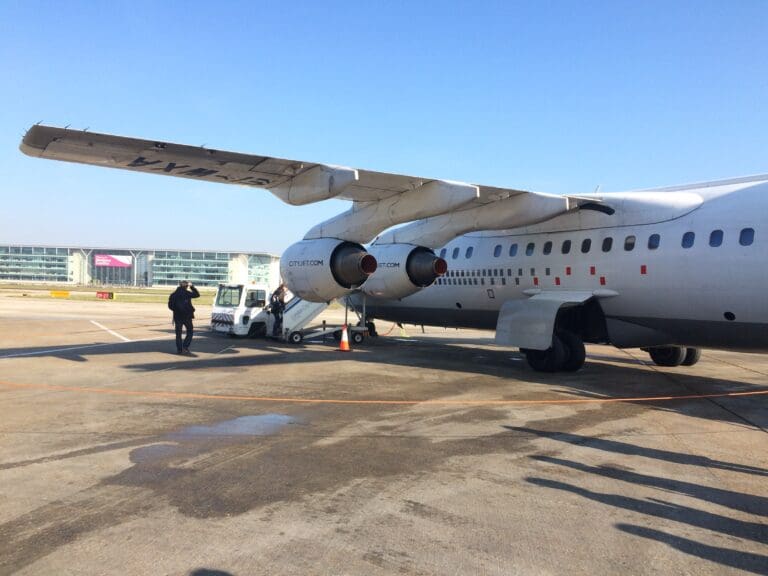
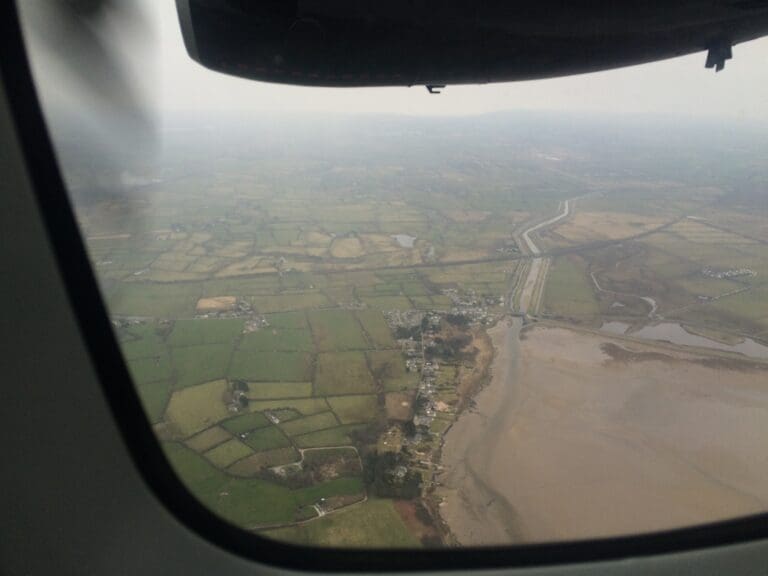
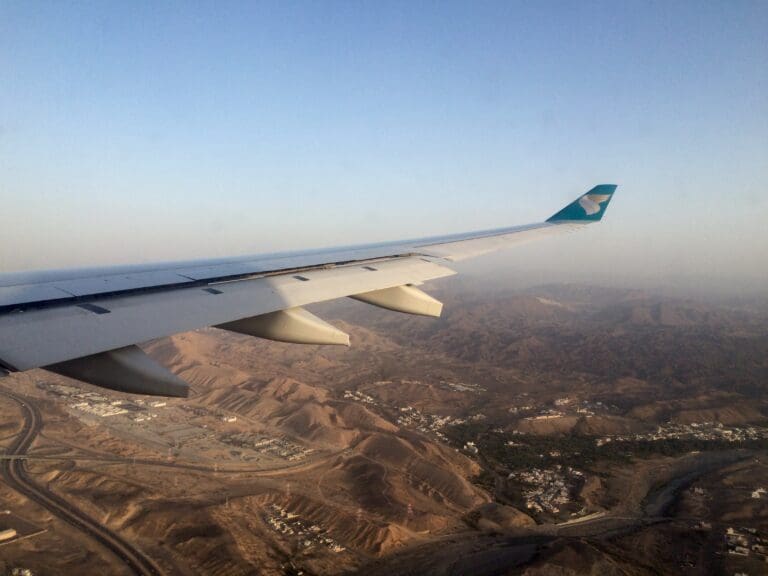
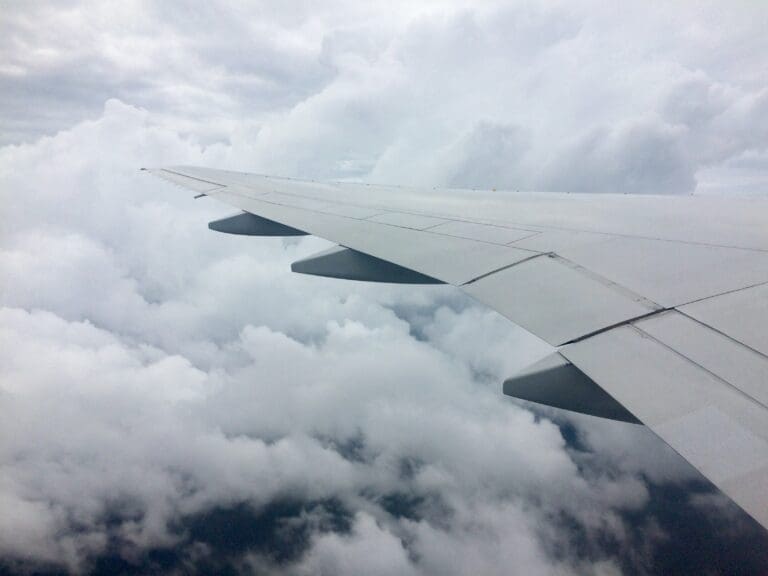
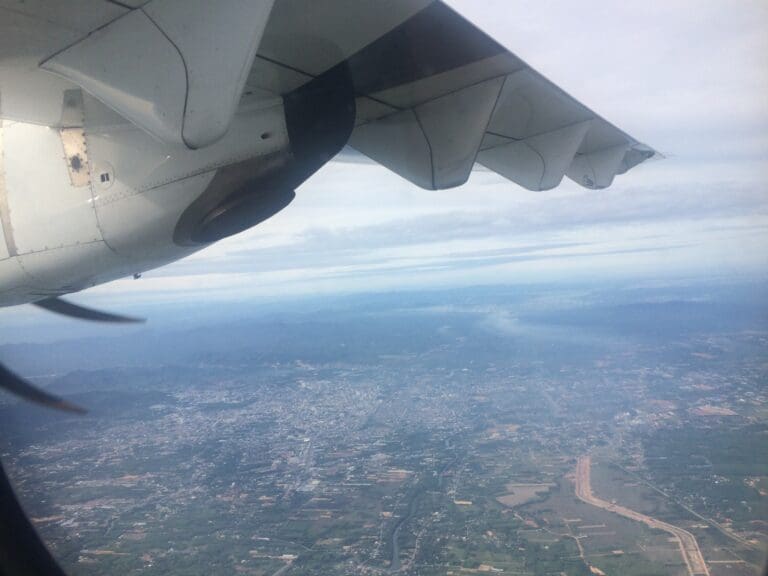

Lovely write up!
Thank you very much! I’m glad you enjoyed!